#migratory bird to return once the season is right
Text
The first two drawings are the nicest. They stay up here (but also because Jesus this takes Space)
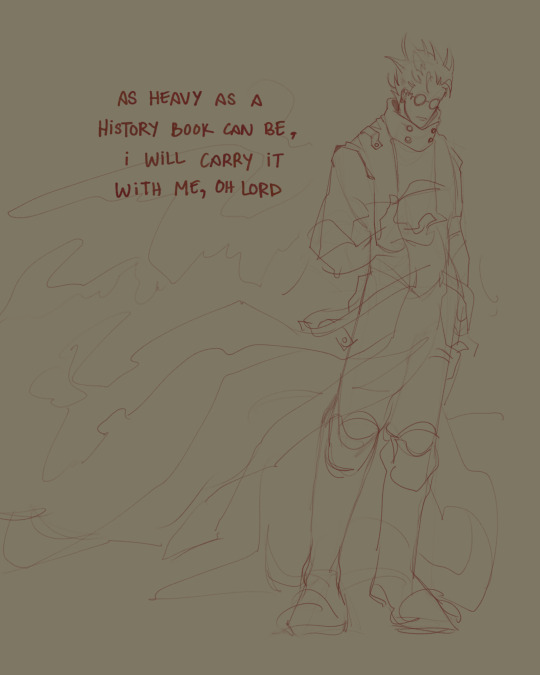
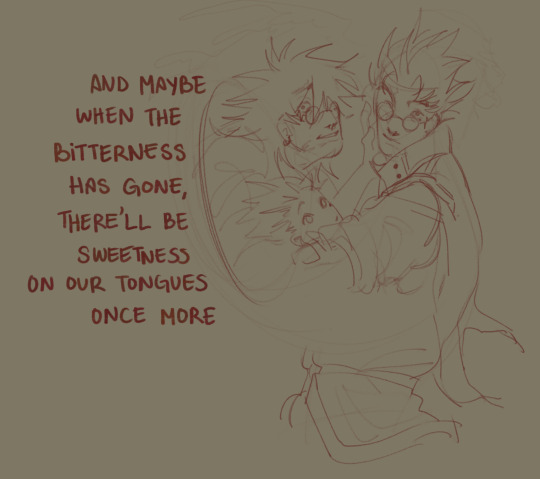
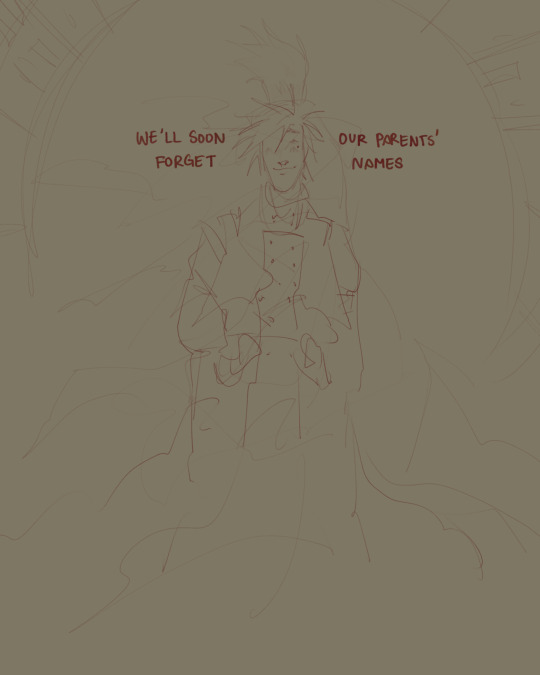
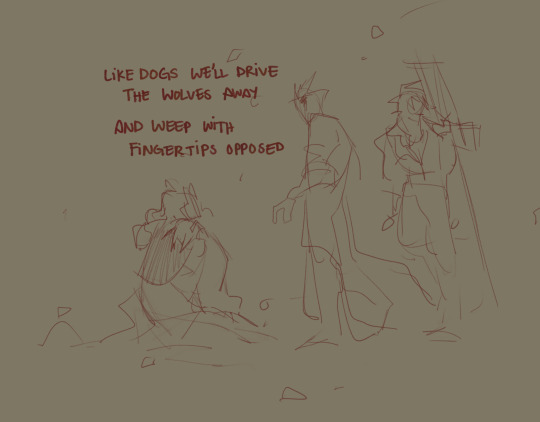

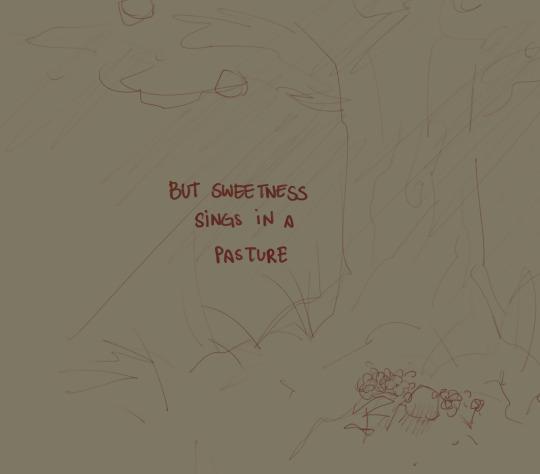
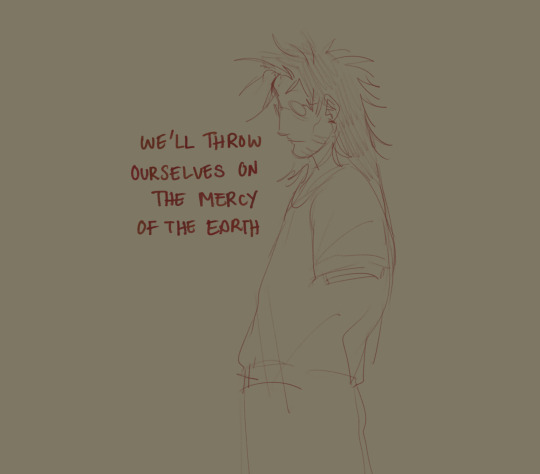
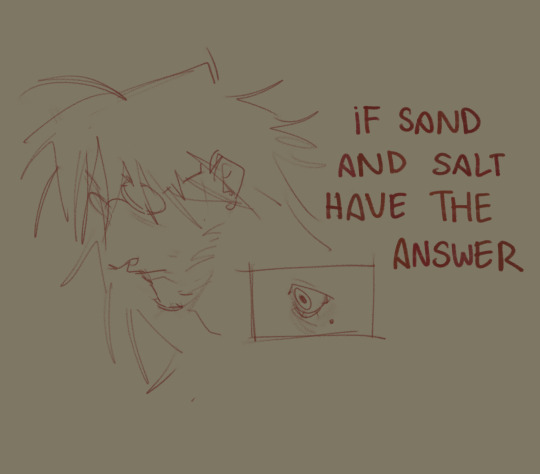

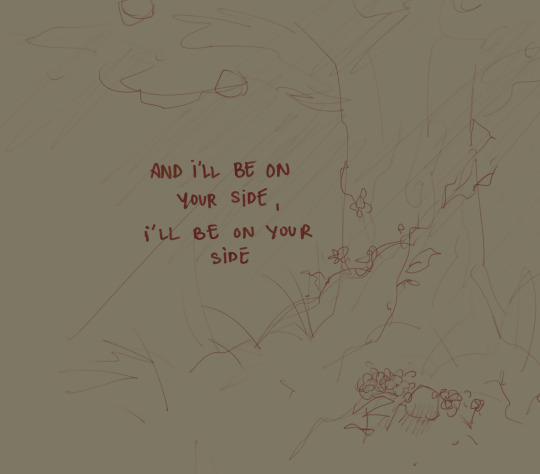
Aggressively points at the entire Shallow Bed album
GODDD IM HAVING SUCH. BRAINWORMS WITH LIKE 5 SONGS INCLUDINF HISTORY BOOK IN REGARDS TO TRIGUN ITS INSANE
BIBLE BELT? WOLFWOOD. UUAHHHGGHGGH
#trimax#trigun#trigun maximum spoilers#i guess?#vash stampede#nicolas d wolfwood#meryl stryfe#milly thompson#it’s just. god. aughfnff#bystander eternal witness to history and future#burden no one has ever carried all placed upon shoulders that even atlas would envy#plentiful of mercy of patience of love#migratory bird to return once the season is right#IDK MANNNNN. I HOPE HE GETS TO REST. I HOPE HE LIVES OUT THAT QUITE PEACEFUL LIFE#ALONGSIDE HIS SISTERS OLD AND NEW#ALONGSIDE FRIENDS OLD AND NEW#MAKING MEMORIES AND REMEMBERING MEMORIES#AND HE GETS TO FUCKINNGGGG REST#small mercies to be able to love all of them again#(the three small figures is Rem Tesla and Knives. in that order. beeteedubs)#checkadii
127 notes
·
View notes
Text
Have some Asra n Muriel disorganized headcanons: animal themed!
Asra's most likely to answer quetzal if you ask for his favourite bird (he had a close up encounter with one his first time in nopal and had never seen a bird like it so it's a special memory), but he also appreciates all others. He also loves dart frogs and his favorite reptile would of course be perfect lavender angel baby fictional fantasy pythons. I'd also see him loving dragonflies as well.
He will see literally any animal generally and always say "they're one of my favourites!", though. It doesn't matter how many times he's said it that day or how many animals he's said it about. It's almost without fail he'll point one out and say it's a favourite.
One of his favorite animals is always the one in front of him Right Now, as a quick reference.
Plus, he loves to point animals out on travels or when out and about Vesuvia, so get used to hearing it!
He may attempt to catch critters occasionally too, or just pick them up, these will be mostly bugs usually. He just likes to cup moths in his hand on occasion and the watch them flutter out and I think he should be allowed to! Or just cradle bugs in his palm and watch them walk around for a bit. If it's a reptile or amphibian somewhere it could get stepped on or dried out or eaten he will still scoop them up and carry them to the brush.
[Cont. after cut]
Nothing he ever handles seems to get too upset or stressed, even when it's an animal that otherwise would. They just seem to be more relaxed if it's Asra who's touching them. Sometimes reptiles just come up to him (or even crawl onto his hand, as a few lizards have,) curiously enough. Though they may still refuse to be touched even then, they're notably not bothered by his presence when for others they'd run away. It's not something Asra's ever noticed to be odd, nor would it be overly noticeable to most people, but it's definitely something you can recognize if you pay attention.
Asra would also love to run on the beach sometimes, namely as a kid, maybe making himself invisible or otherwise undetectable until he's right up on a big flock of seagulls before giving them a hearty boo! And watching them all fly away all giggly. As an adult he may still stir up flocks for fun sometimes, or just to see how pretty it is to watch them all fly at once.
In general he just loves watching birds or bugs or whatever be it fly, always so effortlessly. Maybe he wishes he could fly himself. It certainly would make things easier he would come to think time to time growing up in Vesuvia.
Plus, he likes to collect the feathers that flutter down. Back when he sold masks, they were something he incorporated into them often. Then, too, he would also sit by the river after wearing himself out practicing hydromancy or what not, and a few times dragonflies would perch on him. He'd always gasp n grin all big and goofy when they did.
Muriel doesn't pick favorites really when it comes to animals (barring wolves and bears), but he does mirror Asra's 'one of my favourites' statements by saying "they're one of Asra's favorites," Occasionally.
While Asra's animal encounters or observations are typically brief, Muriel is more than content to just watch animals long periods of time. He can spot or at least know where to find some seriously elusive ones. The only one such animal Asra seems to have luck like that with seems to be foxes.
If you want to see an animal, local to the area around Vesuvia namely, Muriel can probably help you with that, granted he trusts you. This includes dens, hives, and nesting sites of course, things he will stop by occasionally in his forest to check on. His luck/skill in finding these things can't seem to be mimicked by even the most skilled animal trackers, you'd think they were practically just showing themselves to only him.
Muriel is also content to let animals do their thing and not interact with them much. Birds, butterflies and similar may land on him occasionally and he's always enchanted by it though, and will make no move to prevent an animal being on or touching him. Similar to Asra, he will also remove any animals in bad spots and put them somewhere better. He's a bit more effective at this though, as he tends to be looking down anyways, while Asra has probably smooshed a few pillbugs and snails before while doing his own thing- eyes elsewhere.
If Muriel did ever nerf a bug accidentally he would probably feel pretty damn bad, and if it wasn't reduced to a mere smear he would return its poor bug corpse to nature so that it might reclaim it. He'd get over it quick though if he was in a good mood prior, just give him a moment. If he was upset over something else already and he killed one, I could see it even pushing him to tears or rather making it worse if he was already at that point.
Asra would probably be like 'awh.... :( oof, I'm sorry lil guy...' and sweep it into nature if he could, but otherwise he would not be impacted too much.
Asra would purposely kill bugs on a few occasions even, pest bugs namely - like flies or mosquitoes or, of course, plague beetles. He may even instinctively lash out and flatten a bug that simply resembles a plague beetle enough, particularly if something had his anxiety or panic (ptsd trigger from the plague??) going. Otherwise plague beetle resembling beetles he'd be a little unsettled by, or uncomfortable to be around, but not enough to necessarily kill. He'd either move it somewhere else, try to scare it off, or move away from it. Muriel doesn't have many hang ups on plague beetle resembling bugs, though he would probably kill the real deal readily.
Any dead animals not in a wild area (like left in the city or on a road,) Muriel would move as long as it wasn't yknow. Too nasty. Birds that hit windows, starved or sickly scavengers, anything that dropped in a heatwave or was claimed by a flood, things like that, recent deaths. It pains him to see at all, but pains him more to leave them just.... There. Some he may bury, others he may leave out in places where there's animals he know will take it for food.
Injured or sick animals Muriel would try to help best he could, and he's successfully done it a few times. If it's blistering hot he'd also likely leave water out here and there for the animals of the forest, and he may enlist Asra's help with this to replenish water in natural water basins as well in droughts.
Muriel can handle animal death okay, hunting and fishing is a thing he does to some degree, it's just the preventable or senseless ones that hurt, it's worth saying here. It's just sad. He'll be okay after though, unless there's something more nefarious and upsetting at play.
Asra helping unwell/hurt animals would mostly consist of magic healing, but beyond that he wouldn't know what to really do besides bring it to Muriel or any animal experts near him. He doesn't come across these situations too often thankfully, though. Domestic animals he would take in more readily, and would let crash at the shop for a while if he can. If it's a livestock animal he'll ask if Muriel wants to take it in, or even in the case of an ownerless pet animal. If not, he can ask around. See if anyone wants a new dog or cat or... Goat. I just imagine those are the kinds of animals he's most likely to find in need, being in the center of Vesuvia.
Moving on from that....
Animal knowledge!
Asra likely doesn't know a ton about animals outside of ones that feature prominently in magic and myth, he's just good at identifying them and overall tends to appreciate their presence. Identifying animals can make for good pass times on long travels, or if he just sees something particularly neat he may simply want to know what to call it. He also probably learned most the common local Vesuvian species names growing up, probably through reading, though the bulk of his knowledge of the nature he grew up around is probably botanical- foraging can be dangerous! Plus, magic knowledge probably leans more heavily on plants than animals as well.
If Asra can't identify an animal, though, he will simply make up a name for it on the spot. If he finds out it's ID later he will still refer to it as his made up name followed by AKA/sometimes called/locally known as [real name]. He also tends to refer to tons of animals as the infamous, famous, legendary, revered, etc. Regardless of relevance, commonality or obscurity. He just thinks they all deserve such titles, and when has a little flair ever hurt?
"Ah, MC, look! It's an Abramesmerwhymsical Zadithi midnight-billed stilt-wader! Though it's sometimes also known as the famous crab-plover," Kinda shit. He enjoys it.
Muriel doesn't actually know the actual names of a ton of animals species. He knows of a few though, not to mention the Asra-given names that stuck with him. Despite not knowing their names sometimes still, he can tell most all species apart readily, and juveniles from adults, males from females, things like that. He watches animals of the forest regularly and is in tune with the local species life cycles, breeding or rearing seasons, migratory patterns, unique behaviors and everything else. Though his knowledge is probably limited to Vesuvian species, he's able to quickly pick up on other animal's traits and such when outside of Vesuvian territory, and is generally good with animals as is.
He knows what doves/pigeons and owls and vipers and mice and geckos etc are. He may not know that a specific species of such is called like, namaqua doves, omani owls, ocellated mountain vipers, cario spiny mouse, kotschy's middle-toed geckos n shit. It's not like he has NO idea, species names are weird and can be long winded so....
...He just doesn't know that dunnocks aren't actually called stripple-caped tseepers.
But he doesn't need to. <3
If he does learn the real names for them though, he is quite glad and will use the name readily. If you're looking at a Muriel who's in the city more, he will probably read up on this information himself, but otherwise he would of course treasure it if MC told him.
The only reasons he doesn't even know the names to begin with is mostly because the names you'll hear out and about most commonly only cover a fraction of species to start, and everything else youre mostly going to have to study via reading or classes. Neither of those seem to be things a young homeless Muriel would care to pursue lmao.
Annnnd
I forgot what else I was going to add and lost track so, I'll maybe add more later. I'll probably also amend this as I may find I don't agree with my own statements the next day and also I don't proofread so. I hope u enjoyed these feel free to add on or add differing opinions!
31 notes
·
View notes
Text
Hakuoki Yuugiroku 3 Fall Saito Story
managed to recover my first post of the year which seemed to have disappeared from tumblr via exporting it…
hope everyone had a safe and happy new year… recently hit 500 followers over the holidays so I’d like to say thanks for appreciating the stuff I’ve uploaded and my translations (I kinda feel the need to say this but: I am an adult who occasionally uses crude language so please be aware of that. Also, i don’t run an image-focused blog. i only wanted to post everything that I thought wasn’t available as clean images online so that people would be able to find and access more Hakuoki content… and i do believe i have done that for the most part).
Threw together a list of things that I hope translate this year into in one of my other posts today… here’s hoping that it will be less volatile than 2020… tho im not expecting much given the news yesterday though i can’t say that i didn’t expect it.
Anyway. translation. Story from the 3rd Yuugiroku game.
The CN of the title I have for this translates to the effect of “The fate/return/destination of (a) migratory bird(s),” which I think looks weird and I’m not sure how accurate that tl is, so I’m just going to categorize these stories by season and char lol. not that it’ll be any time soon before I go and translate another one of these since this did feel quite long…. and it’s not like anyone else is translating these (please someone translate these xD there are 2 side stories per route and i am not looking forward to torturing myself with them!).
also, a significant portion of the punctuation and stuff wasn’t used in the tl i found for this, so that will be reflected in this… will fix it later.
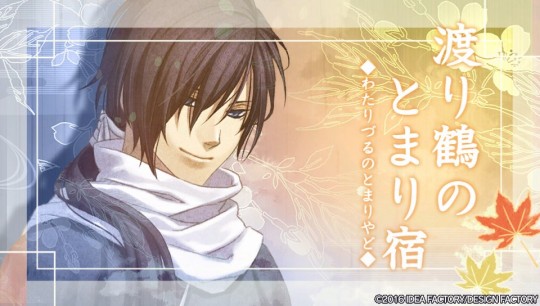
Hakuoki Yuugiroku 3 - Fall Saito Story
Translation by KumoriYami

That day I was delivering Hijikata-san’s message and came to Saito-san’s room.

Yukimura Chizuru: Saito-san, are you there?
[I] Called him from outside his door but he didn’t seem to hear me.
Did he go out?
But the other warriors clearly stated that he was in the room.
Using a slightly louder voice, I called again.
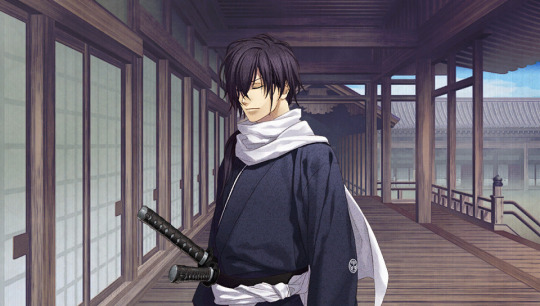
Yukimura Chizuru: Ah, Saito-san are you there?
Saito: Yukimura, is there something [you need]?
Yukimura Chizuru: Hijikata-san said that he had something to say to Saito-san so I was asked to get you.
Saito: Vice-commander? I see.
I got it/I understand I will go at once, you’ve worked hard, Yukimura. [I’ll check the game for punctuation later….probably?]
Yukimura: It’s rare, for Saito-san didn’t hear me calling you.

Saito: I was concentrating, [and] I didn’t hear your voice.
Yukimura: Concentrating? Was it on sword maintenance?
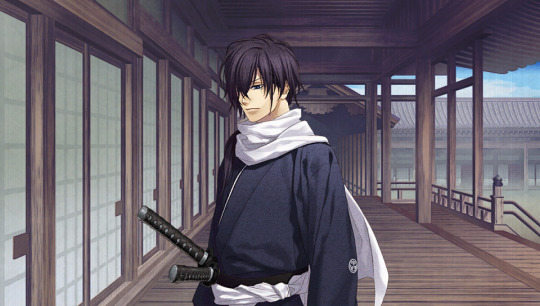
Saito: nn, more or less.
Yukimura: ......?
It was rare for Saito-san to answer questions in such vague terms.

Saito: Isn’t (the) vice-commander calling me? I’ll hurry up.
Saito: You can go back.
Yukimura: I understand, then I’ll be going now.
I gently lowered my head and prepared to leave Saito-san’s side.
Yukimura:......
His unusual mood made me feel a little worried.
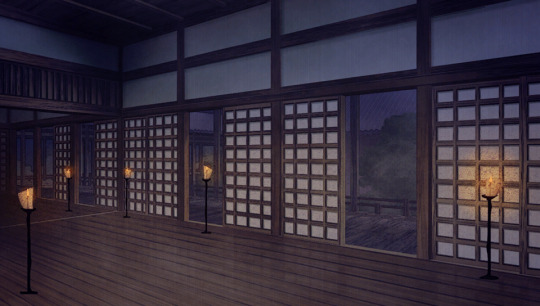
Afterwards at dinner, there was a strange/unusual incident.
Saito-san who finished eating earlier than everyone else set down his chopsticks.

Heisuke: What’s wrong are you already full Hajime-kun?/Hajime-kun you’re already full?

Saito ……Nn.
Yukimura: There’s more of Saito-san’s favourite tofu.
Saito: I’ve had enough for now, I’ll be leaving first.
Leaving behind those words, Saito-san bought his plate into the kitchen.

Nagakura: What’s wrong with Saito? It’s simply unfathomable for him to only eat a small portion of tofu.
Harada: It doesn’t look like he’s feeling unwell, so maybe he secretly ate earlier?
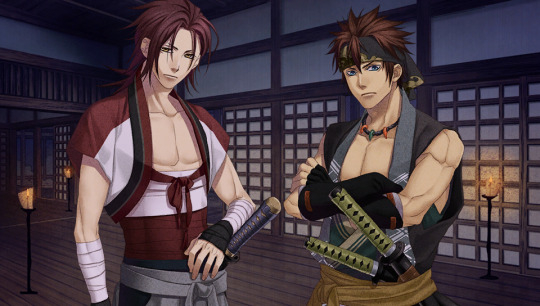
Yukimura: What, Saito-san isn’t a person who would do something like that.
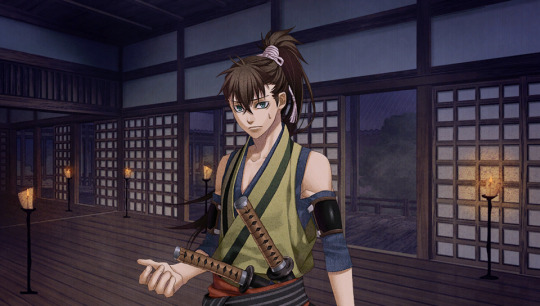
Toudou: Hajime-kun’s been acting weird lately. In the morning today, he went back to his room right after practice.
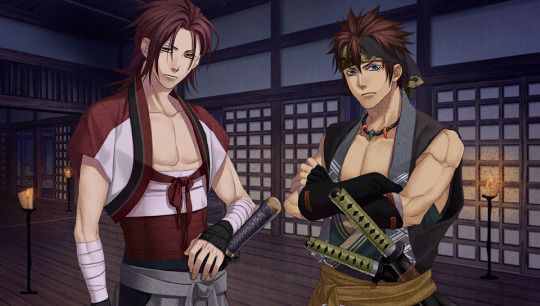
Nagakura: did he have a headache? Sano, did you ask him?
Harada: If he doesn’t want to say anything, then I can’t ask.
Nagakura: If this continues, perhaps something permanent might happen [gave up rewording for now lol].
Yukimura:......
What was wrong with Saito-san?
Was something bothering him?
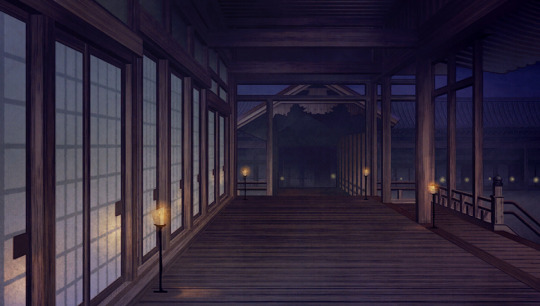
A few days later.

For the sake of mending the warriors’ uniforms, I went to the common room [tl is large main hall].
Chizuru: Ah, you’re here, Saito-san.
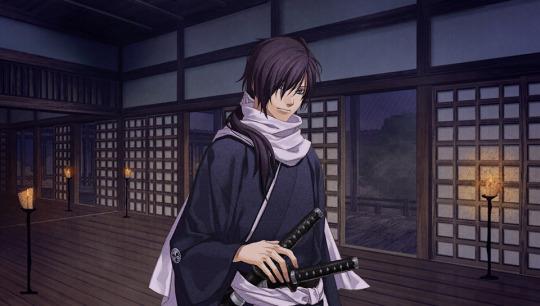
Saito: ! Yukimura——
Saito-san hid what he was holding behind him in a panic.
What was it?
It looked like a book.

Saito:……Will you be mending clothes here?
Yukimura: Yes, will this bother you?
Saito: No, it’s no bother.
Yukimura: Then I’ll be mending/sewing here.
I took out my needlework box and began mending the clothes.
Saito-san seemed to be hesitating about if he should stay or leave/ leaving or staying.

Yukimura: Um.
Saito: What?
Saito: Was Saito-san reading something just now?
Saito: Ah, um, nn, more or less.
Yukimura: Don’t mind me and continue reading.
Saito: But.
Yukimura: Am I bothering you?

Saito: No, but……
Saito-san looked very confused, after…

Saito: Yukimura.
Yukimura: What is it?

Saito: I hope you don’t tell anyone else that I was reading this book.
Yukimura: Don’t tell the others?
What was going on?
To actually not want any of the other warriors to know about this book.
Could it be that this book was on something, like assassination techniques, that shouldn’t be passed onto others?
I felt a bit uneasy.
Yukimura: I understand. I will never tell anyone else.
Saito: I believe you.
With a sharp glance at me, Saito-san began to read again.
The cover of the book looked badly worn.
Yukimura: Is that a manual on kenjutsu?
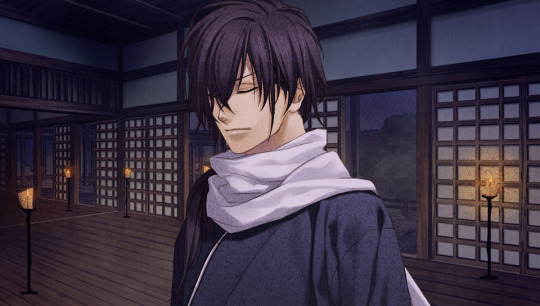
Saito: Yes, I happened to find it a few days ago, and took it to read. As a result, I’ve started reading this without stopping. If I have time, I’ll read. [reword later]
Yukimura: So it was like that.
That’s why Saito-san has been behaving strangely lately.
Yukimura: But why don’t you want to let the other warriors know?
There was no need to hide a swordsmanship manual.

Saito: That, because. The author of this book and I are not from the same school. Reading manuals from other styles is considered unethical.
Yukimura: I see.
I couldn’t help but laugh at such serious reasoning.
But, that truly was Saito-san’s style.

I started sewing again as Saito-san to read again.
We focused on our own things, and while we were in the same room, it however was natural for there to be no dialogue.
Retreating to the tranquility of the autumn night with only the sound of cicadas, [reword later] and the occasional sound of Saito-san turning a page.
Suddenly I was very interested in that sound and was looking in/looked in Saito-san’s direction.
Focused on reading, his entire posture was completely serious.
My heart felt happy just by looking at him, and I unconsciously smiled.
As a result, he noticed my staring, and while his gaze didn’t leave the book, he asked me a question.
Saito: What’s wrong? Is there something on my face?
Yukimura: No, Saito-san’s expression is very earnest/serious.
As a result, Saito-san tilted his head slightly, murmuring quietly.
Saito: So there’s nothing strange. I don’t understand what you’re thinking.
Yukimura: If I’ve upset you, I’m sorry.
Saito: I’m not upset.
Saito-san lightly sighed, adjusting the way he sat slightly.
Yukimura: Saito-san really loves kenjutsu.
Saito: I don’t have any other skills, but I do have some knowledge about kenjutsu/experience.
Yukimura: Ah, a talent/Oh my.

The conversation ended like this, and Saito-san once again began focusing on the manual.
From time to time, there was the sound of pages being turned.
The silence was soothing. I continued sewing the clothes.
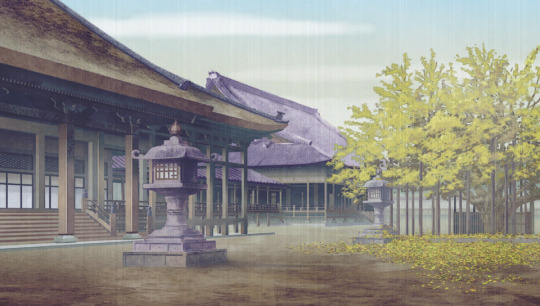
A few days later.
I finished washing the clothes, and was about to head back into my room.
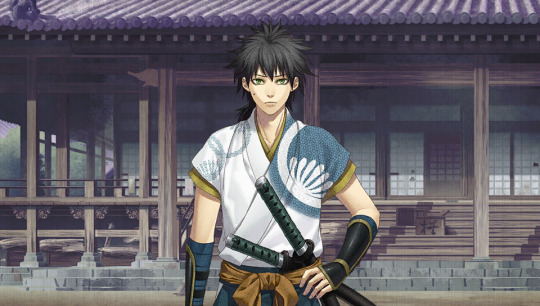
Nomura: Spare me, Saito-san. There’s no way we can defeat Saito-san./How could we beat Saito-san!
I saw Saito-san, Souma-kun and Nomura-kun practising with the blunt side of their swords [check jp mtl].
It looked like he was trying to put what he had read in that book a few days ago into practice.
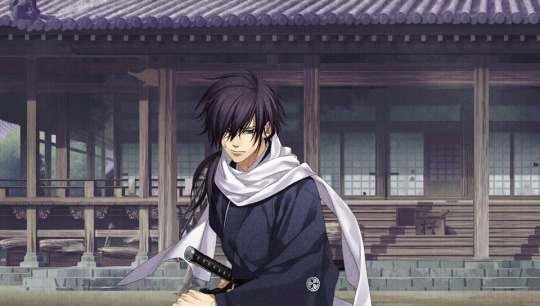
Saito: A little bit more, just a bit more and I’ll have grasped it. One more time.
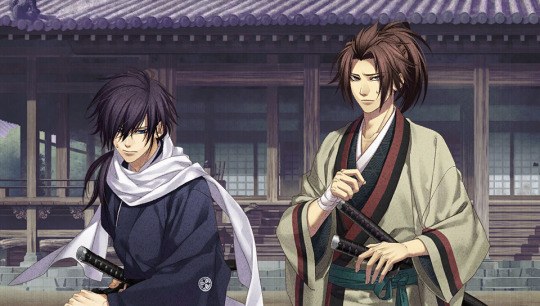
Souma: But we’re going on patrol next. Regardless of what is said, we can’t neglect our duties as members.
Saito: I’ll finish this as as [you?] obtain a point. There won’t be any problem.

Nomura: To quickly get a single point, what the hell is that! This is terrible.
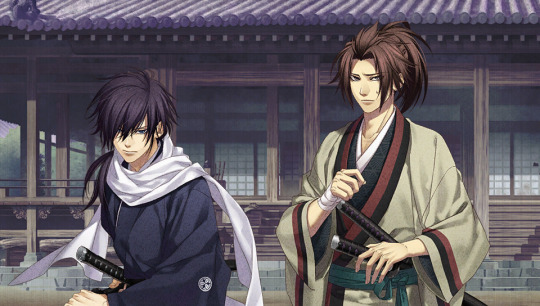
Souma: But it’s pointless to continue like this…

As of the three of them talked, Nomura noticed me an started speaking with me.

Nomura: Ah, Yukimura-senpai, you’re just in time.
Yukimura: Ah, just in time for what?
Nomura: Why don’t you ask Yukimura-senpai to practise with you, Saito-san?

Saito: Ask Yukimura?
Yukimura: This, that’s not something I can do, there’s no way I can fight Saito-san.

Nomura: That doesn’t matter, we’re about the same [skill] level.
Yukimura: But…
Nomura: We have to go on patrol later, so please help us.

Souma: Nomura, don’t force Yukimura-senpai like this. Yukimura-senpai is also very busy.
Yukimura: ......
Fighting against Saito-san will be incredibly difficult.
Yukimura: Saito-san, am I okay [acceptable?]?
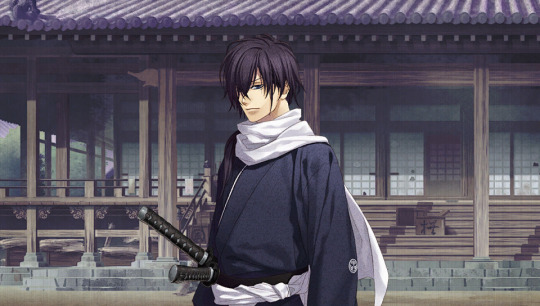
Saito: Is that okay? Have you been instructed to do anything?
Yukimura: I’ve already finished with those things. However I don’t know if I’ll be of any use.

Saito: That is more than enough, thank you, Yukimura.
Yukimura: Not at all.

Nomura: The we’ll be going to work, so we’ll leave this to you, Yukimura-senpai!
Souma: Is this really okay, Senpai?
Yukimura: There aren’t a lot of opportunities to learn/This is a good opportunity to learn.
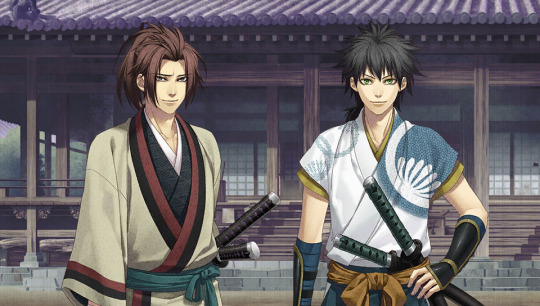
Souma: Then, we’ll be leaving/take our leave.
Yukimura: Okay. See you.
The two of them went directly back into headquarters to prepare for patrol.
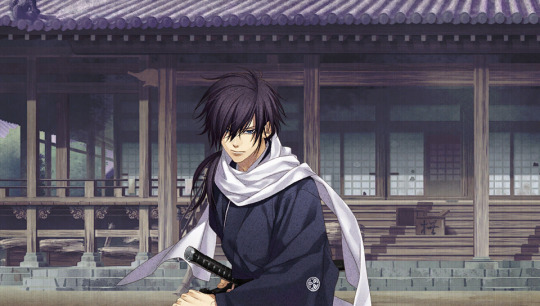
Saito: Then, let us begin, Yukimura. Are you ready?
I took a stance a distance away from Saito-san, and held up my kodachi.
Yukimura: Please advise me. [well not sure what the JP equivalent of this is….]
Following the silence, my entire body was filled with a sense of tension [reword later].
After.

At the sound of my foot stepping forward, in a split second, Saito-san was facing me.
Chizuru: !
I hurriedly prepared myself, but he was faster than I was.
Yukimura: Ah!

My kodachi flew in an arc and landed on the ground.
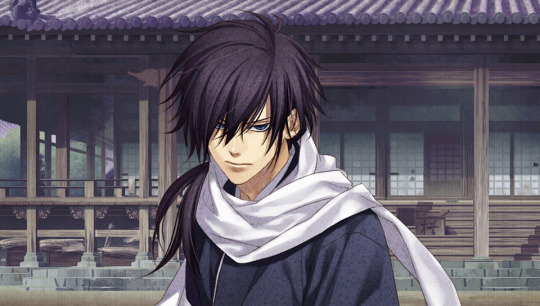
Saito: Ippon.
Yukimura:……
Saito-san’s killing intent left me speechless.
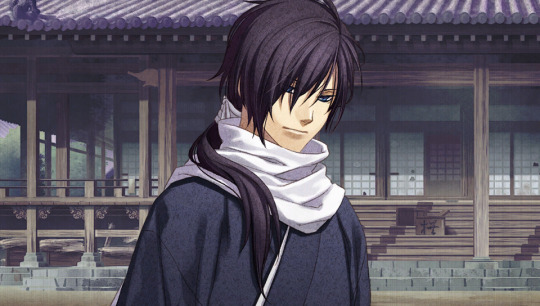
Saito: As expected, knowledge acquired from reading needs to be tested in real combat.
As Saito-san spoke, he picked up my kodachi, which had fallen onto the ground, and handed it back to me.
I received it with trembling hands.
Yukimura: Thank you very much.
Saito-san became stronger again.

Saito: The fact remains that you have also improved, Yukimura.
Yukimura: Is that so……
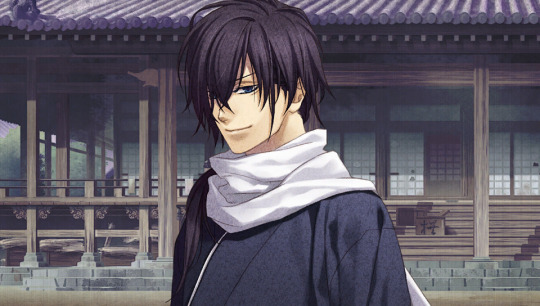
Saito: Let’s return now. It’s about time to prepare dinner.
Yukimura: Yes!

Afterwards, Saito-san and I helped prepare dinner together.
—-end—
next week’s post is Saito’s 7th Ginsei no Shou chapter!
#hakuoki#hakuouki#hakuoki yuugiroku 3#hakuoki game translation#Saito Hajime#Yukimura Chizuru#souma kazue#harada sanosuke#Toudou Heisuke#nagakura shinpachi#Nomura Risaburo
33 notes
·
View notes
Text
Kaze ga Tsuyoku Fuiteiru Chapter 4 - The Track Meet (Part 3)
Full list of translations here
Previous | Next
It was difficult for Kakeru to get back on his feet once his rhythm got thrown into disarray.
Impatience clouded his eyes, and he couldn’t properly ascertain his own condition; no matter how hard he threw himself into training, he still felt like it wasn’t enough. He ran and ran, but he didn’t actually feel that his speed was increasing—his time wasn’t shortening as he wanted it to. I take extra nutrient supplements regularly and I’m running so much, so why? He got impatient again. Even so, he couldn’t stop running. He was too scared to stop because he felt like he was going to end up in an even worse state.
Even after the main training sessions, Kakeru ran until the sky became completely dark. Like a fish that would suffocate if it stopped swimming. Like a migratory bird that would fall into the sea if it didn’t flap its wings.
As though possessed by something, Kakeru continued to go on long, hard training runs. The residents, who at first watched in admiration, soon began to feel there was something unusual in the way Kakeru trained.
“Kakeru, practice is over already,” they started to call out to him. “We’re having tonkatsu for dinner tonight. Haiji-san went home first so we can eat it freshly fried. Let’s go home too.”
“I’ll go after running a bit more.” Answering a worried Jouji with a few words, Kakeru ran to the back of the field in the approaching dusk, like a ghost running with only his eyes glowing.
Kiyose didn’t say anything in particular to Kakeru. Sometimes he would say, “Kakeru, you’re running too much. Be careful.” But the rest of the time, he watched quietly. Kakeru didn’t like that either; it seemed to him that Haiji-san wasn’t serious enough, telling him to refrain from practicing, and it was also dissatisfying that he didn’t concretely tell him why he shouldn’t run or what he could do to get faster without running.
Even though Kakeru himself thought he was training hard, ironically, instead of his time shortening, it was gradually increasing. Even at the Kanto Intercollegiate, he could only run as well as the injured Kiyose. Although he wasn’t outstandingly bad, it was a mediocre time for a runner in an intercollegiate.
It was already the rainy season.
One evening, when Kakeru returned from jogging, he was stopped by Kiyose who was in the kitchen. Kiyose was facing the dining table, apparently working on a training plan. The other residents seemed to have already retired to their rooms, so Chikusei-sou was quiet. While wiping his rain-wet hair with a towel, Kakeru obediently sat in the chair facing Kiyose.
“Let’s put off taking part in the All-Japan Intercollegiate. For me and for you too,” Kiyose said.
Kakeru was of course stunned, and he furiously opposed.
“Why? I want to run.”
“Even you should be able to tell that you’re in a slump. The hard training might have made you a bit anemic; it’s better not to push yourself at times like this.”
“Unlike you, Haiji-san, I’m not injured. I’ll be back in shape as soon as I run.”
“I wonder,” Kiyose said, tilting his head with his eyes still on the training journal. “I think it’ll be a waste no matter how much you run, in your current state. You’re not looking at your own body properly; all you’re thinking about is how you compare to other runners and things like that. Competing in the intercollegiate at a time like this will have the opposite effect.”
“That’s out of the question.” Kakeru slammed his fist against the dining table. “We’re in a situation where there are still people who haven’t surpassed the seventeen-minute wall, right? Even though it’s not a sure thing whether or not we can even participate in the Hakone qualifiers, you’re telling me to not take part in the intercollegiate? So, where should I leave my records? Are you going to make me waste this year going along with you guys?”
“Are you only running for records?” Kiyose smacked the paper in his hand against the table. There was a hint of frustration and anger as he stared fixedly at Kakeru. “If so, that’s the same as a coach who only manages his athletes to make them single-mindedly pursue speed. It’s the same viewpoint as those guys you once hated and rebelled against!”
“You’re wrong!” Kakeru shouted. He didn’t want to be lumped together with his high school coach. But he couldn’t even confidently explain to Kiyose how he was wrong; it was true that he felt burdened by everyone at Chikusei-sou, who could only ever run slowly, and part of him had also looked down on them and thought, “What a bunch of hopeless morons.”
Kakeru appealed to Kiyose, desperately searching for the words. “You can’t get faster if you just run half-heartedly. Running in a university track club and aiming for Hakone aren’t at the level of running for fun, are they? What we’re doing is a competitive sport!”
“Of course. There’s no one in Chikusei-sou who’s running half-heartedly. I’m not aiming for Hakone as a hobby or as a spur of the moment idea,” Kiyose answered calmly once again, as usual. “Kakeru, what are you so impatient about?”
“Impatient…”
“What’s the matter?”
Prince suddenly poked his head in from the door to the kitchen. Looking between the two, a tense air about them, he asked, “Are you fighting?”
“It’s nothing.” Kakeru stood up from his seat.
“You weren’t asleep? Do you want something to drink?” Kiyose smiled.
“Yeah, I’m thirsty.” Prince opened the fridge while still peeking worriedly at Kakeru and Kiyose.
“You understand about the intercollegiate, right?” Kiyose said to Kakeru, who was leaving the kitchen, making doubly sure. “It’s your senpai’s order.”
“Yes,” Kakeru answered and crossed the hallway, slamming his room’s door shut.
He lay down on his futon, but sleep didn’t visit him readily. From the other side of his thin window, he could smell the faint scent of water that night as well.
At the third track meet, King was also able to get a time within seventeen minutes. Prince, the only one left, was training with all his might amidst the pressure. However, that was still a level that could only be called soft, if you asked Kakeru.
Why was Prince staying up so late in the first place? Kakeru thought, irritated as he stared up at his dark ceiling. He must have been reading manga again, even though he’s in a position where he should live a more well-regulated life than anyone else and he has to go on a long run early tomorrow morning.
Prince and Kiyose seemed to be talking about something in the kitchen, but their footsteps retired to their rooms before long. Kakeru could hear Prince walking right above him.
It was a cheaply made old house, so they could hear all of the noises from each other’s daily lives. Prince seemed to be digging up his own treasure trove in search of the manga he wanted. There was a fluttering sound of books sliding down onto the tatami. Don’t read manga, go to sleep already. Kakeru covered himself with his thin blanket, tucked in his limbs, and silently prayed in his mind.
Soon, there was a sound like a poorly maintained windmill coming from the second floor; Prince had begun to run on his treadmill while reading his manga. It was so noisy that Kakeru couldn’t sleep. He tore off his blanket and threw a ballpen that was lying next to his futon at the ceiling.
That trivial sound went unnoticed, and Prince continued to run on his treadmill in the room right above Kakeru for a long, long time.
Even Prince was doing his best. At first he hated running so much and gave up immediately—now he was practicing late at night by himself without telling anyone, in order to participate in the Hakone Ekiden and its qualifiers with everyone at Chikusei-sou.
However, Kakeru couldn’t honestly acknowledge Prince’s efforts no matter what. He could only think of efforts that didn’t bring in results as meaningless.
Without knowing if he wanted to be angry or cry or laugh, Kakeru covered himself with his blanket again and shut his eyes tight. Even when he covered his ears with his hands, the sounds of the treadmill creaking as it ran relentlessly poured down from the room above.
Previous | Next
30 notes
·
View notes
Text
Tundra Trouble
A dramatic population increase in “Light Geese” is threatening sensitive tundra habitat.

What are Light Geese?
"Light Geese” are actually three separate species of goose named after their mostly-white plumage. They include...
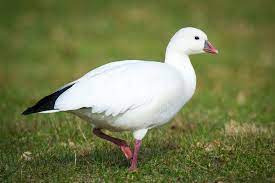
Ross’s Goose
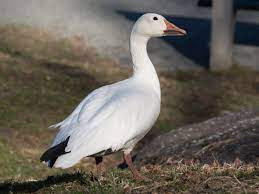
The Greater Snow Goose
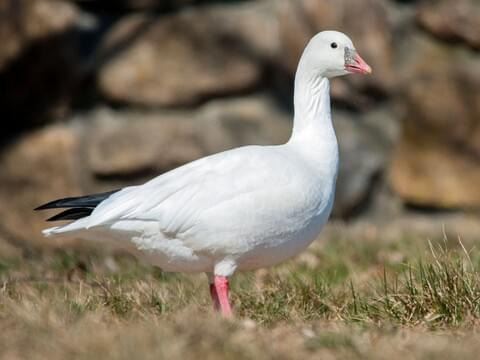
And the Lesser Snow Goose.
The main different between these birds is size (which can overlap) and slight variations in color. If they are this hard to differentiate in photos, imagine how it much be for duck hunters to identify them. Don’t worry! None of these birds are threatened in any way. In fact, the problem is the exact opposite...
Tundra Geese
All three of these species breed and nest in the tundra habitat of North America.
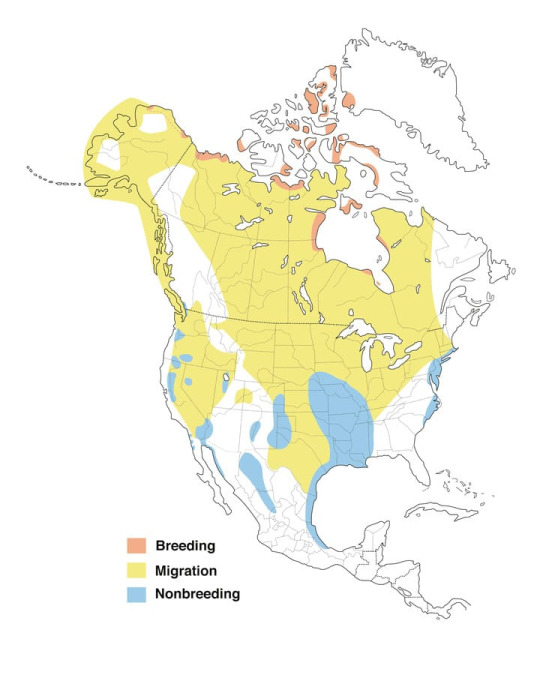
The little spots of red on this map signify where the geese nest in the spring. All three geese nest in the same kind of habitat: Tundra.

Now, let’s talk about Tundra.
Tundra is a kind of biome found in cold climate or very high elevations. It is dominated by mosses, roots, and tubes, all ‘short’ plants without deep roots. This is because of a permanently frozen layer of the soil, known as permafrost.
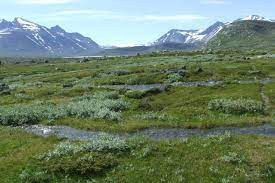
Plants that live here also have to deal with low precipitation, and a growing season that can lasts between 50 to 60 days, or about 2 months. This makes the biome incredibly fragile. If something were to come along and remove all the plants or disrupt the soil, it could take many years for the foliage to recover, if it does at all. Compare this biome to a place with a longer growing season, like the Midwest United State. All the grasses can be removed by grazing and burning, and within the same season, new seeds can take root, and within a couple of years, the grassland is completely back to normal. This is why oil and mining projects in the artic are a big deal, because the kind of damage we see them cause in relatively robust ecosystems will be so much worse in a tundra.
Tundra’s have relatively low biodiversity - there’s only a handful of species that live there in the productive months, and even less in the winter. However, it is a major producer of birds, especially migratory species. Breeding habitat is critical for every species. Tapering with it can directly alter a population’s ability to replace itself with the next generation. It is far more effective to reduce a population by tapering with habitat than removing individuals through hunting.
Light Geese and the Tundra
Like I said earlier, all three species of ‘light geese’ are not threatened. In fact, their population has boomed significantly. Since the 1970′s, the population of light geese has grown by more than 300 percent, and continues to increase by 5 percent each year. According to an article on Ducks.org, waterfowl managers estimate the total population is up around 17million.
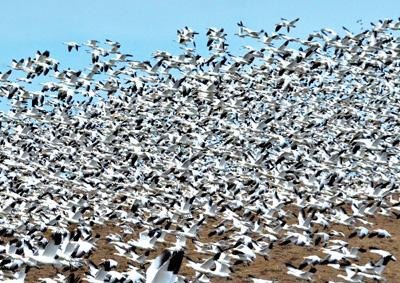
Now, is this actually unnatural based on science? It’s hard to say. We don’t really know if this population number matches historic numbers, because we didn’t really take bird surveys until the late 1900′s. Some bird populations, like the extinct carrier pigeon, was so big they would supposedly black out the sky. Maybe, ecologically, we are suppose to have millions of light geese. But there is one thing we do know: they are over-grazing the tundra.
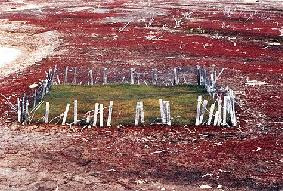
That little square of green once covered a much larger area. Researchers protected it with nets to keep geese out, and all the red in the picture is bare overgrazed soil. Geese don’t just eat the green, the dig up the roots, preventing new growth. Once an area is grazed up, the flocks move to another green space and repeat the cycle. There is nothing much left in terms of food or habitat for other animals on the tundra.
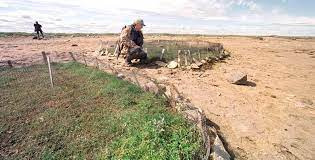
But how?
Nature has ways of balancing populations with available resources. When resources are used up, populations go down until resources go up again. So how did the light geese population rise to the point of environmental destruction? If you guessed agriculture, you’re right!
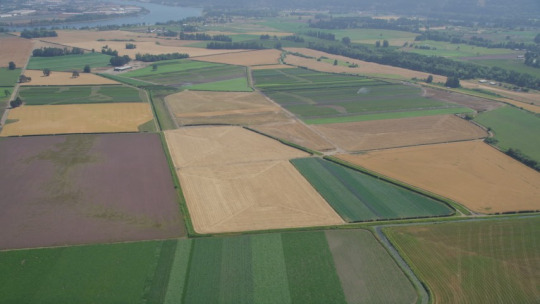
The later half of the 1900′s came with a boom of farmer productivity thanks to new machinery and chemicals. It helped support a booming human population, and apparently, geese as well.
Usually, migratory birds loose weight during the migration. They have to depend on their fat storage for through the summer and winter to make the 1,000m+ trips. It serves as an important environmental pressure: only the best equipped birds will survive the trip, and have the opportunity to pass on their genes. Lack of food fuels competition between individuals to establish dominance or territory, and at the same time reduces competition as it weeds out unfit individuals. Take the pressure away, and you are a step closer to the light geese problem. Light geese actually gain weight during their migration thanks to all the food available. By the time they return to their nesting ground, a lot of individuals are healthy enough to breed and rear offspring.
The parental habits of light geese are another piece in the problem puzzle. They all practice lifelong monogamy, and both parents are constantly around to guard the young. The young themselves are precocial, meaning the are fluffy and walking around almost immediately after hatching. They can even feed themselves. The only thing the parents need to do is fight off predators - and geese do this exceptionally well.
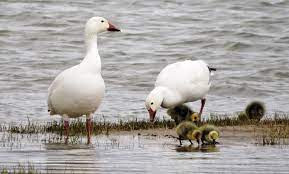
There are nest predators, like owls and foxes, but they are only able to take so many. Predation alone never has much of an effect on a population - it has to be coupled with a signifanct habitat factor. For example, if you released a fox into a small pen of 10 geese, the fox would immediately reduce the population in the pen. But, if you released a fox onto a large plot of land full of 100 geese, the single predator would never be able kill all of the geese. This is of course, a small-scale example.
Another problem is the flocking. Snow geese flocks can easily exceed a hundred individuals. This makes it easy for hunters to shoot a large amount of birds, but the thing is, they have to get the birds within range first. Duck hunters lure flocks over a body of water by setting out wooden decoys. Since birds feel safer in large numbers, they are drawn to the groups of fake birds. This works if you, for example, put out two decoys, and it attracts a lone duck. However, a flock of over a hundred is not going to find any reason to join a fake flock of 2. To decoy for geese, hunters need a lot of decoys, which is more expensive and time consuming.

Geese are also uncannily smart. They live long lives and can remember places where they were shot at, so avoid them in the next years. That means that most geese that end up shot by hunters are the younger, inexperienced ones who do not contribute much to the population anyway.
Solutions
Managers and researchers are currently searching for ways to fight this problem and protect the tundra, while also not totally wiping out light geese populations. One of the most effective ways to reduce the population would be to disrupt the breeding habitat, but that’s option is not likely. Remember: the tundra is a delicate ecosystem. No disturbance could be significant enough to affect the light geese and not effect other species. Targeting food supplies isn’t realistic either - we can’t poison the tundra grasses, and we can’t throw giant nets over crop fields.
The usual solution to overpopulation of a game animal is lessening hunting restrictions. Hunters can take over a hundred geese in a season - if they can get a flock within range. But that leads to another issue - who wants to carry, clean, and process over a hundred birds? Ammunition availability and prices are another concern.

Another factor that makes any management work in the tundra difficult is accessibility. There are few towns and fewer roads that give people access to nests, so sending in people or dogs to collect/destroy them isn’t always a practical option. Article on possible solutions.
Fish and Wildlife’s suggested lists of actions:
Expanding hunting seasons/limits
Expanding hunting methods (allowing electronic callers).
Far north harvesting.
Egging.
Increase incentive to harvest by award programs, donations, market hunting.
Improve private land access.
Information and education programs.
Bird trapping and culling by wildlife managers.
Refuge management.
Sources
https://www.fws.gov/birds/management/managed-species/light-geese.php#:~:text=Ross's%20geese%2C%20lesser%20snow%20geese,to%20remain%20at%20high%20levels.
https://ucmp.berkeley.edu/exhibits/biomes/tundra.php
https://link.springer.com/article/10.1007/s13280-019-01308-5
https://www.fws.gov/migratorybirds/pdf/management/snow-geese/light-gooseFEIS-QAs.pdf
https://www.nature.com/articles/s41598-019-46487-z
https://www.wildfowlmag.com/editorial/whats-the-best-method-to-control-the-snow-goose-population/280168
6 notes
·
View notes
Photo










08/08/20-Bee and buddleia in the garden and birds and butterflies on another scorcher at Farlington Marshes
It was lovely to watch the yellow and purple buddleia in the garden before we went out today in very hot sun glowing nicely, seeing Large White butterfly and bees around it. I took the first picture in this photoset of bees and buddleia in the garden.
This afternoon I made my return to the coast again this year after an obvious gap in going there due to strict lockdown, visiting the coast for the first time since we went to Portland and Lodmoor in Weymouth, Dorset the culmination in principle of our splendid June week off which kicked off here at Farlington Marshes. On the hottest of days once more today it felt so good to make the most of being at the coast and the sea air. I just loved seeing everything look so blue and pure and I liked the almost creamy look of the landscape with the hot and bright sun sitting nicely on the edge of the clouds all walk with some interesting cloud formations in the air too. I took the second, third, fourth and fifth pictures in this photoset the views here today, as well as the eighth of some seaweed (or similar) very visible in some incredibly clear water beside the sea wall.
As we walked along the sea wall I was very happy to see a big and erratically flying butterfly come towards us, we just made out it was a Painted Lady. It was the first time I had seen this iconic migratory butterfly species this year after seeing them again and again last summer in a boom year where I did see one here. This made me very happy they are a special butterfly and never one I’m guaranteed to see in a year. But to fall flat after last year with them would have been sad. It’s butterfly 41 of my year which I am so thrilled with it’s only one butterfly behind the amount I saw in 2018 so I still have a shot at making my butterfly year list my second highest ever behind last year which is something it would deserve for how lucky I’ve been that its been this good. It was my first butterfly year tick since Chalkhill Blue at Stockbridge Down four days sky of a month ago so it was nice to tick off another species.
What’s more it was the only butterfly that you can submit sightings for in Butterfly Conservation’s ‘Big Butterfly Count’ which I had yet to see whilst doing it this year. I was able to include this in a big butterfly count today so it’s the first time I have ever counted every single species at least once over the course of this survey in the summer so this felt amazing. Elsewhere in the count I saw 7 Gatekeeper, 5 Small Heath, 3 Meadow Brown, 2 Common Blue and Large White, 1 Small White and 1 Peacock.
We saw some top wading birds on the lake, including many splendid bronze plumaged Black-tailed Godwits, full plumage Grey Plovers and lovely looking always Greenshanks in big numbers. As we walked around the sea wall we came to a nice piece of reedbed where we got a cracking view of a Sedge Warbler. It was great to see one of my favourite birds and what’s more for a second time in a year after my first of the year at Common Marsh in June. These days I do rather often only see them once in a year or the second might be when it’s a bit easier too when watching the BTO ring them in the demonstration at the Bird Fair at Rutland Water. So it was good to see one twice this year, and even more positive in a sense this coming here and Common Marsh and not along the River Itchen at Shawford where I saw them the last two years as it broadens where we can rely on to see them when the time comes in years now. I also saw a gorgeous Hobby fly over the lake putting all the birds up from here.
As we had a nice walk along the sea wall we saw loads of orange erratically flying butterflies that were a little smaller flying around the grass, the dirt and the wall and even out to sea. They could only be Wall Browns, a butterfly we had seen that day in Portland but didn’t get the very best of looks at with it flying over the bill car park. But today there was no doubt these were Wall Browns and it was fantastic to see them again they are so beautiful. One of our most prominent species of butterfly really. They frequent this kind of raw, relatively bare/short grassed habitat often by the coast. They do seem to have had a burst out in this hot weather judging by social media. This was special though as this is the first of the species I have ever seen in my home county Hampshire. This is a species I first saw in Pembrokeshire, Wales in a perfect coastal path location for them and saw them again and again there and it was mind blowing enough finding out they were about in neighbouring Dorset at Portland in 2016 and Durlston in 2017 I’ve seen them in Dorset between those two locations mainly Durlston every year since but to actually have them in my home county is something else as I associated them as a far away species really. I really was so lucky to see so many of then today what an experience. All of this really underpinned what I’ve learnt the last couple of years and our last visit here in the late spring that this nature reserve we’ve always known for birds is a fantastic location for butterflies too with so many about in the season. It does stand to reason actually as its renowed for its rare and varied grasses I was once told on an information tour round there.
We walked in the grassy cut through and were happy to see and hear hundreds of Starlings probably noisily chatting and flying and piling into trees. A hive of activity which it was fun to witness many flew over our heads. I took the seventh picture in this photoset of some in trees. There were also quite nice large groups of Oystercatcher flying high over us against the blue sky at this point which was lovely to see too. I took the sixth picture in this photoset of them no Farlington visit is complete without this bird the last few years I’ve found, and ninth and tenth pictures of Meadow Pipit and Redshank both on posts nearby to each other it was great to see them both stars of Farlington too especially the former which I saw my first ever of here in 2007. A brilliant way to safely spend a very hot day today I did really enjoy it.
Wildlife Sightings Summary: My first Painted Lady of the year, four of my favourite birds the Little Egret, Shelduck including a young one, Sedge Warbler and a Buzzard that like a Carrion Crow sat on the same pole for the entire visit pretty much which was memorable, Hobby, Goldfinch, Starling, Linnet, Rock Pipit, Meadow Pipit, Reed Bunting, Woodpigeon, a cracking view of a Swallow right beside my head over the sea, Herring Gull, Great Black Backed Gull; Black-headed Gull, Mediterranean Gull, Mallard, Moorhen, Canada Goose, Redshank, Greenshank, Black-tailed Godwit, Lapwing, Dunlin, Grey Plover, Ringed Plover, Grey Heron, Wall Brown, Gatekeeper, Meadow Brown, Small Heath, Large White, Small White, Common Blue, Peacock, a dragonfly could not quite see which with how fast it flew and moths.
#moth#dragonfly#butterfly#bird#bee#bees#birds#butterflies#birdwatching#hampshire#dorset#pembrokeshire#uk#farlington marshes#butterfly reserve#grass#bird reserve#nature reserve#portsmouth#england#earth#nature#world#beautiful#photos#photography#sunny#sun#heatwave#heatwave uk
7 notes
·
View notes
Text
Distant Shores: Chapter 1
Far into the waters of the Silver Sea, there was a small island nestled in its vastness. A band of Sifa gelfling called this island home, living on the land for many a trine. This place also served as a midway point for many sea fairing travelers who needed rest, repairs, and to restock their stores. The port was quiet, save for the gentle lapping of the waters against the ships’ bows. A small trail snaked its way from the port to a small village nearby. Warm lights shone brightly in the night as homes were preparing for slumber. One however was buzzing with tension.
A group of six gelfling was sitting around a fire pit, faces solemn. One of the gelfling looked pale and eyes glazed which was in stark contrast to his dark orange coat and fire red tricorn hat. Dolen let out a coarse cough, the gelfling woman sitting to his left resting a hand on him in concern. She looked similar to the coated gelfling, except her hair was copper orange while his was maroon laced with grey. He cleared his throat before pulling out a letter from a pocket. “You all know what this is,” Dolen said hoarsely. The others nodded in silence. He rested the letter on his lap. “I cannot make the journey to Cera-Na, not when I’m hacking and wheezing like a beached hooyim.” He let out a tired sigh, looking like a gentle breeze could easily knock the gelfling over.
No one spoke, the situation choking out any talk. The Omerya-Staba was docked at Cera-Na, indicating all Sifa must return. The old Sifan maudra had abdicated her throne and now her daughter would take her place. The elders must come to give their blessing to the new maudra as is tradition. But Dolen had fallen ill beforehand. It wasn’t life threatening, however it had prevented him from leaving his hut. The gelfling woman sitting next to him frowned. If she had to be the one to state the obvious, then so be it. “Someone has to go. If not, the rest of our clan will see this as a sign of disapproval.” Some of her peers nodded while others clenched their jaws. “What do you suppose we do,” asked a male gelfling sitting across from Dolen. His face was worn from traveling the harsh oceans. “The elders must go. Not even their right-wings can go in their place!” She glared at him, freckled face scrunched up. “I am not letting my father sail when he can hardly stand!”
“Enough,” barked Dolen. The outburst caused him to go into a fit of coughs.
The two gelfling closed their mouths. The male gelfling lowered his gaze. “I’m not suggesting Dolen goes…but who can?” The room fell silent once more, except for Dolen’s coughing. He spoke up when he regained his composure. “Liliah.” His daughter turned to him, resting a hand on his lap. “Yes?” The elder gazed at her, eyes stern. “You and Ekoi are right; someone has to go in my stead, someone who holds the same authority as me.”
He took Liliah’s hands into his own. “Ekoi cannot be my replacement. No one on our island can…except for one.” The woman’s heart was pounding against her chest, like the waves crashing against a beach. She swallowed, waiting for him to say the words she so desperately wanted to hear.
“You must go in my place.”
The room gasped. “B-But she isn’t an elder! She hasn’t even gone passed the Spirals,” said a gelfling. Liliah was about to snap at them but Dolen beat her to it. “She may not have the experience as the rest of you, but her boatmanship is impeccable! She did have two amazing mentors after all,” he added with a twinkle in his eye. Liliah smiled. It was good to see a glimmer of his old self. He then became serious again. Dolen took sip of water before addressing the group. “We need to be at Cera-Na in a unum. It will take half a week for us to make the Silver Splitter sea worthy and to prepare enough supplies for the trip.”
He looked to his daughter. “I suggest you study the maps, captain.” Even though there was pride in his voice, there was a quiver of apprehension. Liliah grew stoic, setting a slim hand over her heart. “I will. I won’t fail you.” She then turned to the rest of her band. “I won’t fail us. We will go to Cera-Na to give our blessing. Nothing will stop us, come hell or high water!” Her words moved the group, clapping and cheering ringing throughout the hut. Liliah gave them a large grin. She looked to Ekoi. “Will you help me, right-wing?” She leaned toward him, offering a hand. Without hesitation, he gripped the woman’s hand firmly. “Of course, captain.” Dolen nodded in approval.
He waved the group off. “Off with ya. You’ll all need your sleep, as do I. Pleasant dreams.” The rest of the gelfling bowed to him and then left. Only Liliah and Dolen remained. She helped her father up and led him to the bed in the far corner. He started to take off his coat. “You should rest too, my darling. You’ll have a busy day tomorrow.” She shook her head. “I need to make sure YOU go to bed first.” He huffed, setting his hat on a hook on the wall. “Oh how the tables have turned. Instead of me tucking you in it’s the other way around!” Liliah rolled her eyes before helping him to bed. “Good night, father.” She kissed his forehead. “Good night,” he said tiredly.
The woman then made her way to a curtain, pulling the fabric aside. She entered the room and sat on her bed, head buzzing with excitement. The Sifa couldn’t believe that her lifelong wish was finally coming true. She laid down, too elated to sleep.
***
Days had passed. News of Liliah’s departure spread like wildfire, leaving the island bursting with excitement and fear. The island gelfling were now busy on the Silver Splitter. Liliah was watching them from the dock, eyes shrewd. Her thick braids were swaying in the gentle breeze, bringing with it the smell of the sea. A few of her crew went passed her, whispering quietly to each other while giving her side way glances. Even though she couldn’t hear their words, she knew what they were.
The new captain didn’t address them. She wouldn’t let them get the better of her. Instead she closed her eyes to took it all in; the saltiness of the air, the squawking of migratory birds, and the noise of the waves hitting the ships.
“Captain Liliah.” She opened her eyes and turned, pearl earrings swishing as she did. Ekoi dipped his head to her. “We are almost ready to sail.” She nodded in approval. “Good. The sooner we leave the better. It would be embarrassing to be the last to show up.” Ekoi chuckled softly. “Yes, it would.” The two were silent for a moment. Liliah took a deep breath, trying to settle herself. “Is it normal to feel this nervous,” she asked Ekoi softly. The older man smiled. “It wouldn’t be normal if you weren’t.” She felt relieved. Ekoi patted her back, making sure to not hit her sapphire blue wings. “You’re not alone. You got a crew full of dedicated and well-seasoned members at your beckon call.”
She appreciated the reassurance, but there was a thought nagging at her brain. “It’s not that I don’t trust the crew’s capability…I’m worried they won’t accept me as their captain.” Ekoi eyes light up with surprise. The copper haired woman folded her hands. “I know there are those among the crew who think I am unfit to sail…in truth I don’t fault them for their doubt.” She didn’t dare look at Ekoi. She didn’t want to see him agreeing with her.
“Do you want to hear the advice some crazed gelfling told me once?” Liliah furrowed her eye brows, confused. “…Yes?” Ekoi gently rested his hands on her shoulders and forced her to look into his brown eyes. “You can learn all the wisdom in the world from stories and songs. But that doesn’t mean anything if you don’t see the world for yourself.” Liliah felt a lump form in her throat. She knew that saying all too well. She put her hands on Ekoi’s shoulders, squeezing them in thanks. He grinned warmly at the younger gelfling.
Liliah broke away from him, regaining composure. “We better board the ship. The wind is starting to rise.” She started to make her way to the Silver Splitter but was stopped by Ekoi. “Wait, we’re still waiting for our last member.” Liliah raised an eye brow, fists on her hips. “Who? Last time I checked our crew is on board.” Ekoi simply replied. “All but one. She should be here soon.” Before she could question him further, a rumbling came from the ground. Fear gripped Liliah like a clawed hand. “Is it an earthquake?!” Her right-wing on the other hand was calm and motionless.
Suddenly a burst of water shot upward, nearly hitting the docked ships. Liliah ducked, shielding her head with her arms as a roar erupted. “You can look now.” The gelfling opened her eyes, letting out an audible gasp. A behemoth of a sea creature was near the dock, easily eclipsing the sun from her view. Its back was covered in what appeared to be mountains. She willed her legs to move, but she was too frozen with fear. Ekoi only smiled when he saw the beast.
“Ah, she’s here.”
This is a spin off series of Bonds. This story is set before/during the events of the AU but will not effect the main story.
Guess who finished Tides of the Dark Crystal?!
I was planning this story before I read the book, but I wanted to make sure I at least read TotDC so I could get a feel for the characters. I'll be posting the second chapter soon after! I hope you like it!
Liliah/Dolen/Ekoi (c) Me
The Dark Crystal (c) Jim Henson/J. M. Lee
#The Dark Crystal#the dark crystal au#au#bonds au#distant shores#book#Book series#the dark crystal gelfling#Gelfling#gelfling oc#ocs#Jim Henson#My writing
2 notes
·
View notes
Link
Chapters: 1/1
Fandom: The Far Meridian (Podcast)
Rating: General Audiences
Warnings: No Archive Warnings Apply
Relationships: Peri/Ruth
Characters: Hesperia | Peri, Ruth
Additional Tags: Wingfic, Wings, Alternate Universe - Wings, Wing Grooming, Pining, Mutual Pining, Hurt/Comfort, Emotional Hurt/Comfort, Angst and Hurt/Comfort, Internalized Homophobia, Stargazing, Pre-Canon, they're still in high school, it's really gay, Angst, Fluff and Angst, Best Friends, Friends to Lovers, Non-Sexual Intimacy, Femslash, Pre-Femslash
I decided that angsty wingfic for The Far Meridian was a necessity.
Just a memory of a soft evening atop a lighthouse, filled with unspoken words and un-nameable longing. Girls preening the wings of close friends is totally normal - unless you're pining sapphics suffering internalized homophobia. A continuation of the sunset scene in Ep. 1.10 Whitecaps. I promise it does end soft.
Peri has the wings of a hermit thrush – an elusive migratory songbird that travels at night, rarely visits feeders, and is widely regarded as having one of the most beautiful, ethereal songs.
Ruth has the wings of a northern spotted owl – a nocturnal bird with little white spots like stars on dark brown wings, and big brown eyes.
Title from the song of the same name by The Spring Standards, also featured on this Peri/Ruth playlist.
Say it
Say the words I see behind your eyes
If it’s not hard to say, then it’s a lie
___________
With the brilliant colors of the sunset, the brine seasoning the seaside air, and the sound of the sweetest voice in the world singing where only she can hear, this might be Peri’s idea of bliss. The soft vibrations of unexpected music twines about the two of them in the air atop the lighthouse, much like the winding breeze that breathes through Peri’s feathers. The wind tugs lightly at them like an invitation to sky. That pull revives the muscle memory of flight going back for generations, running all the way down the vanes to stir their roots. But the song reaches even deeper into her, somewhere in the region where her wings themselves are rooted.
It’s a perfect moment, even if something about it aches indescribably. But it’s alright; it’s a familiar nameless ache, one that swells or softens but never completely fades. Maybe it’s more noticeable right now because Peri doesn’t know when she’ll get another moment like this. So, she tries to make the most of it. She keeps her eyes on the sky and drinks in the air and the light and the sound, trying to sink into the sweetness and save the bitterness for later. It works until it doesn’t.
“You could always… go,” Ruth says, but the way her voice trails tells Peri she already knows her answer. “Next semester. It’d be way easier if we could cheer each other on.”
Peri folds her wings in a little tighter, so the wind’s fingers slide off of them. She doesn’t look at Ruth. “I’ve got my online courses…”
“You know that’s not the same.”
Peri leans forward into the railing of the balcony around the light room as she sighs. She’d hoped Ruth wouldn’t make her say it. “Trust me, if I were a turtle with my home on my back… I’d be there in half a heartbeat.”
“C’mon,” Ruth says, stirring the air with a playful stroke of her forewings. The tips of her soft primaries barely brush Peri’s arm. “In the grand cosmic scheme of things, the whole Earth is your home, zooming through space at sixty-seven thousand miles per hour!”
“Sounds more like a racecar than a home!” Peri protests, but she feels a smile seeking its way to her lips.
“You are – impossible!” Ruth exclaims.
Laughter escapes both of them then. It makes the brief tension recede like one wave folding under the next, returning them to bittersweet contemplation of the kaleidoscope sky.
Peri gives a little shrug of her wings and settles them to lay more comfortably against her back. A few of the tertial feathers at the base catch on the cotton of her shirt. She lifts her left wing a little and reaches her right arm around to smooth them back into place. Once it’s fixed and re-folded, she shifts to carefully lean her elbow against Ruth’s on the railing. She does it oh so slowly, so casually that Ruth can move away if she wishes, and Peri will have done nothing but adjusted the way her weight rests against the rail. Her arms practically ache with affected ease, ready to pull back, oh sorry, didn’t mean to bump you, if Ruth pulls away.
Ruth doesn’t pull away. The wind softens into something that barely dances over Peri’s skin. In the resulting quiet, she can hear Ruth breathing. Peri listens.
“I’m really gonna miss you,” Ruth says in a soft voice.
Peri watches the golds and oranges of the sunset deepen toward pink. The clouds holding that brilliant light slide along the horizon like sails before swifter, higher winds than the ones that reach the lighthouse. Words fill her throat, but she doesn’t know what any of them are, much less how to say them. “Yeah,” she finally says. “Me, too.”
The two of them stand together in silence. Ruth heaves a slow sigh. That ineffable ache still lingers, as it always does for Peri: quietly, and constantly. But usually, it’s not this much. Right now, Peri can physically feel it like a sore muscle, somewhere deep in her chest in the same place where the music goes. On the surface far above it, the skin of her wing twitches in irritation. Some of the smaller covert feathers above the corrected tertials still feel askew. She cants the wing upward again, reaching. Her fingers stretch toward the mosquito-bite itch, but it’s right on the back of her wing where it’s hardest to reach.
Peri lets out a frustrated sound. She briskly fluffs her feathers up and then down again, hoping it will sort out the stuck ones without her having to practically stretch her shoulder out of socket. It doesn’t. This probably wouldn’t be as difficult if she didn’t carry so much tension in her arm- and wing-shoulders. The stiffness of it constricts her natural range of movement just a little, just enough to keep those furthest preening spots out of reach and to leave her neck and upper back perpetually tight and sore. Then again, a whole lot of things in her life probably wouldn’t be as difficult without the anxiety causing that tension in the first place.
Peri braces her hands on the rail. She stretches her rounded wings directly backward to brush their tips against the glass walls of the light room, then folds them down again, to no avail. She huffs in annoyance.
“Hey, you okay?” Ruth asks, giving her a sideways look with one eyebrow raised.
“Yeah, just – nghh.” Peri shrugs her wings again, then tucks them down and holds resolutely still. She’s not going to break the spell of this perfect sunset, not going to walk away from this one of the precious few moments she has left just to go downstairs for a back scratcher. “I’ve just got a feather out of sorts right in the back. It’s fine though.”
“Oh.”
Peri tries to keep her attention on the pink-and-gold clouds, and not on the itch at her back or the light press of the arm leaning against hers. It doesn’t work very well, because she finds some of those words in her throat taking shape and slipping half a question past her teeth before she knows what they are.
“Could you – ?”
At the same time, Ruth blurts, “Do you want me to – ?”
They both break off to stare right at each other. Ruth raises her wings just slightly in a hesitant gesture. Peri quickly looks away again.
“Um,” Peri says, hoping the warm glow of the sunset hides her blush. She pulls her wings in scrunched close to her shoulders in embarrassment. She feels the offending feathers stick up along with several dozen neighbors, crinkled up along the folds of skin.
“Sorry, I – uh,” Ruth says. “I meant – I can fix it, if you want. Or not! It’s totally cool, if that’s weird –”
“No! No, it’s not weird!” Peri says hurriedly. It wouldn’t be. It’s Ruth.
But if it were, that’s why it would be: because it’s Ruth.
Peri had Ace or her mom or dad help her with preening often enough, especially in those hard-to-reach spots. It was a thing lots of people did with close friends and family. Ruth practically was family – she ate dinner at the lighthouse half the time, anyway. It wouldn’t be unusual for Ruth to preen her. Peri had seen plenty of girls at school casually combing through each other’s feathers at the end of lunch hour. That was always a little golden window of free time that the two of them spent together, where nothing consequential ever really happened. Now, though, it occurs to Peri that those casual interstices were home to a disproportionate number of oddly precious memories. They rise up clamoring inside her, as if desperate to not become part of a closed chapter.
There was the time they found a crying thrush trapped in an unused locker down by Mr. Santos’ office, and Peri opened it and got a face full of feathers so much like her own. The two of them chased it down the hallway toward the door Ruth held open for it, and the bird flew out into the sky with a call of joy that they both echoed. Then, there was Heidi’s birthday sophomore year when her grandmother sent her to school with a ton of donuts, except half of them got repurposed for a miniature food fight. Somehow, it was exhilarating instead of terrifying. Peri landed a surprisingly accurate powdered donut on Ruth’s head in a puff of white sugar that clung to her hair all day. She quickly experienced retribution in the form of Ruth seizing her and dusting her all over with a cinnamon twist while laughing and leaving sugary handprints all down her sleeves. And then, there was that time the two of them wandered the perimeter of the soccer field at the edge of school and sat together in the grass awhile, chatting and staring at the trees beyond, and nothing interesting happened at all. They were simply together. Something in the stillness of that moment echoed the bliss of this quiet, sunset-glazed evening that she was living today.
Except for the current awkwardness, today had been blissful - besides the unnamed ache, of course, but that was always there. But perhaps Peri and her escaped words shouldn’t have brought up the idea of preening. For some reason, it was something that had never been a part of any of those remembered moments. It just wasn’t something the two of them did. Peri had never questioned it, never wanted to cross an unacknowledged line. Sure, she had wondered in idle moments what it might feel like to run a hand through the softness of Ruth’s dark velvet-edged owl-feathers, to trace the little white spots that speckled them like stars across a night sky. But someone’s wings were so personal, so strong and yet so vulnerable, that she would never presume to ask, not even her best friend. Especially her best friend.
But now, the wings concerned aren’t Ruth’s, but her own. Although she never even considered the possibility before, she knows she would trust Ruth with anything and everything, including this. Including her. And Ruth herself had offered. Minutes ago, the concept of Ruth’s hands on her wings hadn’t existed. But suddenly, intensely, Peri wants. She wants this before Ruth takes the option far away with her when she leaves. The deep ache inside her twists sharply in a strange way she doesn’t know how to understand.
Ruth is still staring at her, twisting her hands together. Peri flushes again, but just says, in a voice that catches on that ache and breaks into a whisper: “Would you?”
Ruth’s face blooms with hope. Being the reason for that expression makes Peri feel like the sun itself. Ruth begins to reach toward Peri’s wing, but checks herself one more time, retracting her hands as if from a fire too warm, too close.
“You’re sure it’s not weird?” Ruth says, brows crinkling in uncertainty.
“It’s not weird,” Peri says again. Thankfully, her voice doesn’t break this time. “Well, I mean, you’re weird, so by default everything involving you is weird, but other than that –”
“Hey!” Ruth puts one hand on her hip. “Rude! You’re one to talk.”
For the second time that evening, they both dissolve into giggles. The beam from the lighthouse’s light swings over them, illuminating their faces with a glimpse of brilliance.
“Okay but no, really,” Peri says after she’s caught her breath. “That spot’s really really bugging me, can you get it?”
“Yeah yeah! Come here,” Ruth says. As naturally as if they’ve done this a thousand times, she reaches out toward her once again and twirls a finger in the air to ask Peri to turn around.
Peri turns and stretches out her left wing, resting her opposite hand on the glass walls of the light room. “It’s right down at the base there, do you see it?”
“Oh yeah, hon, you’re all kinds of ruffled up here.”
For a moment, Peri doesn’t feel anything but the breeze. But just as she’s worrying that Ruth has decided this is too weird after all, careful fingers sink into the mat of soft brown coverts at her shoulder. Very gently at first, and then with deliberate firmness, she starts combing them back into place.
“Yeah, the one that’s really the problem is just belo– ahh!” Peri shivers as Ruth untangles the feather’s barbs from its neighbors and flattens it between her fingers to zip them back into alignment. Then she rubs the pad of her thumb against the feather’s base where it meets the skin, erasing the twinge of irritation with comforting pressure. Peri’s wing involuntarily sags to the ground in relief, yet again crinkling up all the feathers where her wing meets her back into disarray.
Ruth just laughs. “Starshine, you’re gonna undo all my work if you do that. Here, why don’t you sit down.”
“Oh - okay.”
Peri settles herself cross-legged at the end of the balcony. She rests her arms on the lower rail and fully stretches out both wings, resting them on the ground at a more relaxed angle. Ruth sits down behind her, and with a deep breath sets to fixing her feathers again.
If this evening was blissful before, now it’s approaching something more like wonder. It’s hard to believe it’s real. Sitting here watching the bright clouds fade while Ruth cards deft fingers through her feathers, making the skin underneath tingle with pleasure... it’s a whole new kind of exquisite. Maybe the only thing that could make it better would be if Ruth started singing again – and sure enough, Ruth starts humming to herself as she works. Peri’s left wing goes slack, followed by her right as Ruth works her way through the tiny scapulars on her back toward the opposite limb. The corded tightness of those great flight muscles slowly begins to untie itself, chased away by strokes of careful pressure and gentle scratches.
After she finishes the covert feathers at the elbow bend of her wing, Ruth goes quiet and pauses. Peri hums a softest protest in her throat. At the sound, Ruth lays a silent question on the expanse of her ungroomed secondary coverts with a gently placed palm. Peri can’t help but press an answer into her touch.
Ruth chuckles and resumes, soothing sensitive skin and smoothing down all those little rounded feathers. She even massages the underlying wing, wrapping her hands right around the marginal coverts and squeezing her fingers deep into the muscle. How did she get so good at this? If Peri had known earlier....
Ruth continues to hum as she goes, softly enough that she might be just singing to herself. But when she sings Clementine again, the notes trace their way right into Peri’s core, lancing that eternal ache with unbearable sweetness.
This might be both the happiest and saddest Peri has ever felt.
Once Ruth finishes grooming the coverts, front and back, she starts running her fingers along each great flight feather. She hums another song Peri doesn't know, making sure all the feathers' little barbs knit together without gaps.
“Beautiful,” she murmurs in between the notes.
“Huh?” Peri glances at the plain brown wing in Ruth’s hands. “They’re just brown.”
“So are mine!”
Peri rolls her eyes. “Yeah, yours are dark and gorgeous and you’ve got all those little white spots that look like constellations. Mine are all the same and just kind of dusty-looking.”
“What! No they’re not. They’re such a warm color. They’ve got this gradient...” Ruth supports the back of one of Peri’s long primaries with one hand while reaching over the top of the wing to trace the raised rachis on the feather’s underside with her fingers. “They’re kind of pale golden at the base, and then they turn more sort of, I dunno. Like hot cocoa. And look! You’ve got this adorable little stripe of dark tips on your primary coverts. And your alula.” Ruth tweaks the three little ‘thumb’ feathers at the top of her wing.
“Oh.” Peri blinks. “I mean, I guess.”
“They’re right here! There’s no need to guess. You’re adorable, and that’s that.”
Peri rolls her eyes with an exasperated sigh and a smile.
Ruth goes back to fixing up her long remiges. Peri’s wings sink ever closer to the floor, limp with relaxed pleasure. Finally, after what could be either hours or mere minutes, Ruth runs her hands down the length of them and stops.
“There,” Ruth whispers into the evening air, so soft she can hardly hear it. “How’s that?”
In answer, Peri stretches both her arms and wings out to their fullest extent with languorous ease. On impulse, she falls back into Ruth’s chest with an enormous sigh, wings still splayed. The soft whoof of air Ruth lets out makes her hair flutter by her ear.
“Good,” Peri says.
“Good.” Ruth’s voice is oddly high.
Ruth’s chest rises and falls against her back and wing-shoulders, and Peri finds that they’re breathing in rhythm. It’s lovely.
Ruth shifts her arms like she’s not sure what to do with them, with Peri practically in her lap. Apparently, she settles on stretching them out to lay along the margins of Peri’s prone wings. It increases the points of contact between them, and Peri certainly isn’t going to complain. They both hold still, simply breathing, Ruth’s breath brushing against her cheek.
She’s going to miss Ruth so much. The reality of her leaving has been circling closer for days, weeks, maybe even years, but now the fact has finally come home to roost in Peri’s ribcage.
Peri’s body is far more relaxed than usual. But the softness draws an unbearably sharp contrast with this hurting in her chest – – her heart fucking aches.
A shudder of pain that has nothing to do with Peri’s muscles runs through her, making her breath stutter.
“Whoa – Peri, what’s wrong?”
Peri squeezes her eyes shut and shakes her head sharply. Don’t, please don’t, don’t ruin this, she tells herself.
“Peri,” Ruth says more urgently. Her voice is soft, but it goes low and resonant, like she’s trying to throw it across a canyon. Her hands cup Peri’s wings, holding her as they curl inward with pain.
Peri opens her mouth, desperately trying to cough up all the unspoken things trapped in her throat, but she has no idea how to make them turn into words that she can say.
Water wells in her eyes. “I’m sorry,” she says in a broken whisper, and turns her face into Ruth’s neck to hide them.
Ruth stiffens as she leans in, but just as quickly goes soft and curls around her. Her cheek rests against Peri’s head while her arms slide past the curtain of her feathers and wrap around her waist to hug her closer.
“Oh honey,” she breathes, “For what? You don’t need to be. It’s okay.”
Peri’s shuddering breaths shake them both a few times before subsiding under the comforting pressure of Ruth’s arms.
“Do you wanna talk about it?” Ruth whispers into her hair. The evening breeze twists around them, throwing one of Ruth’s stray locks into Peri’s eyes.
Peri shakes her head again, softer this time. She can’t. She wants to. But when she tries to say any or all of the unknown things she desperately needs to, the only sound her throat wants to make is a cry just like that thrush when it was trapped in the locker.
“Did I do something?” Ruth’s voice goes thin with uncertainty. “Was this too much?” Her arms begin to loosen unforgivably.
“No!” She lays her own arms over Ruth’s to keep them from pulling away. Right now, they’re the only thing keeping the ache inside her from growing so large it consumes her. “You’re fine.” You’re perfect. You’re wonderful. You’re everything. Please don’t go, she doesn’t say. She has no right to be saying such excessive things. “Please, just... stay here awhile?”
Ruth tightens her hold around Peri again. “Of course. I’m here, starshine.”
For now, she thinks with a pang, but she turns away from the thought. No matter what happens next, nothing can change the fact that Ruth has soothed her wings and called them beautiful and held Peri close in her arms. That’s real now, and nothing can ever take that away from her. That’s something she wouldn’t give up even to avoid all this hurt. She lays a hand over one of the darker ones splayed across her ribs, and Ruth tangles their fingers together. The gesture makes Peri melt back into her embrace. It acquires even more layers when Ruth brings her wings around parallel to Peri’s own to shelter her from the stiffening breeze.
Although being so close is what made her aching flare up so terribly into this storm of unutterable words and nameless longing, drawing even closer like this gently ushers Peri into something of a storm’s eye. Here, body to body and wing to wing, the aching releases its grip on her, and she finally goes completely soft. She knows it’s still there, rooted deep within her. But for perhaps the first time since it sprouted unnoticed in her heart an unknown number of years ago and began trellising itself all through her chest and shoulders, it doesn’t hurt. It just holds her, steadies her, the same way Ruth is holding her.
The breeze grows cooler and the surf grows fainter as the tide goes out. The pink clouds have long since taken a turn toward purple, and are now fading into dusky violet in an inky-blue evening sky.
Eventually, Ruth stirs without letting go of her. “Hey, Peri, look.” She points out west toward where the sun’s setting leaves a pale halo on the horizon. In between the smoky clouds, there’s a bright pinprick of light.
“It’s you,” Ruth says. “The evening star. Hesperos, the Greeks called it. And Phosphoros, the morning star – back then they didn’t know it was the same thing. It’s Venus, really. But I guess we’ve never really forgotten what it meant to us, in the beginning, when we started looking at the sky. And we’ve carried the story of it with us ever since.”
“Mmhmm.” Peri’s heard this story many times before. But she could spend all night listening to the way Ruth’s voice goes soft and full of awe when she talks about the stars.
They both gasp as a broad streak of blue-white brilliance arcs right past the gleaming planet and vanishes behind a trailing cloud.
“Oh, that’s a fireball!” Ruth exclaims, holding on to her tight. “I’ve never seen one that bright. Blue usually means high magnesium content – quick, make a wish, girl!” She gives Peri an extra squeeze.
“What, because it has high magnesium content?” Peri asks, baffled.
“No, dummy, because it’s a shooting star! Quick now.”
Peri looks out to the horizon where the ‘star’ fell, blinking at the afterimages of its descent. The only wish she can possibly make right now is the one that she doesn’t have words for. Her chest and throat go tight and sharp as she tries once more to force the yearning inside her to name itself, even if only in her mind. But it’s like trying to pick unripe fruit that clings tenaciously to the vine. It’s just not ready. Maybe she herself just isn’t ready.
Then again, maybe wishes don’t need to be trapped in words. That planet glinting on the horizon has meant enough to people to be given many words – names – of its own, but it’s still the same thing it always was. Perceptions must have shifted over time, and yet Hesperia’s own name is a lingering echo of what a light in the sky meant to humans who lived centuries ago. The nature of things matters, but so does the way people feel about them.
Peri stops fighting the thing inside her, and it immediately releases her into the softness of Ruth’s arms again. Okay. Squeezing her eyes shut, she holds the memory of that shooting star close to her heart. She pulls that spark of light into the soft eye of the storm with her, thinking deliberately: this. And then, because her human mind clings to the language it knows, gives it the only vague words that she has.
I hope this works out.
She heaves a great sigh as she sets the wish free and leans into Ruth even more.
“Starshine?” Ruth.
“Yeah?”
“You make a wish?”
“Yeah.”
“Good. Don’t tell me.” Ruth pulls her in closer, until Peri’s nestled into her chest close enough to feel another heartbeat.
They’re quiet. The sky has finally darkened enough that the lighthouse’s swinging beam has become a solid thing in the dimness.
“Did you?” Peri asks.
“Did I what?”
“Make a wish.”
“Yeah.”
“Can we do that? Both make wishes on the same star?”
“I dunno. Maybe if we wish for the same thing? Guess we won’t find out unless it comes true.”
“Well, you’re the star expert. I believe you.”
“Not yet, I’m not.”
“You will be. I know you.”
Ruth only hums in response. Peri feels the vibration of the sound against her back and wings. A chill runs across her skin, making her feathers stand up briefly.
“You alright?” Ruth asks, running a gentle hand along her feathers once more.
“Mmmm.”
The stars are starting to fill all the gaps between the clouds now.
“Do you wanna go back in?” Ruth asks.
“Mm,” Peri says again. “Not yet. Can we stay just a little longer?”
“Yeah. I’d like that. Although my leg is kinda asleep.”
“Oh, gosh, I'm right on it, I’m sorry.”
“Ah, don’t worry. Maybe let’s move back so I can lean on the light, though?” Peri nods.
Ruth lets go of her and scoots the few feet back to the light at the center of the circular balcony. Peri’s heartache whines a little at the temporary loss, but she soothes it with a wordless whisper. She clambers after Ruth and leans against the light next to her, the intermittent brilliance shining through their feathers. She leans into the wing that Ruth spreads for her and the arm that Ruth wraps around her shoulders. She curls an arm around Ruth’s waist, weaving it under her beautiful barred and spotted feathers. The slow, regular creak of the light turning hums behind and below them. Its familiar gleam and grumble insulates them from the rest of the world. They’re cupped in their own little universe of light and sound, nothing but the sky and the sea and the shining.
The weight of Ruth’s head against her shoulder takes Peri by surprise. She hardly dares to glance at it, afraid she might move, but she dares just enough to allow herself a glimpse of Ruth’s dark hair only inches away. It’s really there. She’s really there.
Peri leans her head against Ruth’s, and her chest is a garden thinking of flowers. The two of them share a sigh and watch the stars and the swinging light in the darkness.
#the far meridian#hesperia#whisperforge#peri/ruth#lizzie taking up space#peruth#fanfic#femslash#crop circles#til the sun sets in verona#long post#podcasts
8 notes
·
View notes
Text
Wildlife Rehab Comes to Belmont County

Safe to say Jordan Castello is an animal person. Need proof? She chose Zoology as her field of study when she attended and graduated from Kent State University.
She’s served in many roles since then—volunteer firefighter, a village councilwoman, substitute science teacher, and even a server at a restaurant. And yes, during that span, she’s worked as a humane agent.
But animals are her true passion, and that’s why for the last three years, she’s worked in the field of wildlife rehabilitation. She worked in conjunction with Nicole Hafer Lipstreu, the wildlife rehab specialist in Muskingum County, and the team at Wild at Hart Wildlife Rehabilitation in Zanesville for much of that time since Muskingum County housed the closest rehabilitation centers to the Ohio Valley.
That’s no longer the case. Castello opened Feronia Wildlife Rehabilitation Inc. and has been caring for animals since. This is Castello’s first year open as a facility, and Feronia is now a 501c3 organization.
Castello’s office is in Bethesda, as is her recently acquired 12 acres of the leased property. She has both indoor and outdoor enclosures at her home and is looking to eventually build a free-standing facility on the leased land.
“That is the eventual goal,” Castello admitted. “Eventually, we’ll have a pre-fabricated building for each species—one for birds, one for mammals, and for on down the line. Right now, I don’t have my own permit, but I am a sub-permittee (through Wild at Hart).
“That allows me to accept Category 1 animals. But I can transport and refer animals I cannot work with.”
Being Category I, Castello is not allowed to work with Rabies Vector Species (RVS) like raccoons, foxes, bats, and skunks.
Category I can rehabilitate healthy, orphaned, or non-rabies vector mammals like squirrels, rabbits, woodchucks, opossums. Castello also works with songbirds, both native and migratory, along with waterfowl. Like RVS animals, she can refer and transport Raptors to proper facilities.
Her goal is to eventually become a Category 2 facility, which requires three years of operation as a Category 1, plus the ability to properly care for wild animals that are diseased, injured, or require rehabilitative care.

Baby opossums

A baby rabbit
Special Kind of Care
Helping rehabilitate wildlife is different from caring for a family pet or even a stray. Many of the animals in Castello’s care are considered prey animals.
They require a special kind of handling: the type not many are familiar with and, even for animal lovers, a type of handling that goes against their natural instincts to provide the animals love and affection.
That may be what your dog or house cat requires. But not, say, for example, baby squirrels.
“I’d see people post online about finding a bird, or a squirrel, or possum, and others would tell them to ‘just do this and you’ll be fine,’ and that’s really not the case,” Castello recalled. “And no one has a place locally to take these animals. The closest is in Zanesville, and that’s a lot of critical time wasted driving when an animal is in need of care.
“My passion has always been animals, so I wanted to help.”
Castello is gearing up for a busy spring, as like with flowers, birth in the animal kingdom is ready for its seasonal explosion. But the winter months weren’t without their trials.
Three baby red squirrels were brought to Castello’s care during the late fall, and she’s worked to raise them up during the winter. The trick has been to keep them healthy and ready for a soft release come spring, without handling them too much.
“We will go outside as soon as the weather breaks and start with a soft release,” Castello said. “That will allow them to get used to their surroundings.
“We’ll leave the enclosure open so they can figure things out about how to live and function, but still allow them to return to the nest they are used to. Once they find their place, they’ll stop returning to the nest, and we can close that cage.”
Castello said during wintering, she wanted to make sure they were cared for and kept comfortable, but for the most part, she tried to remain hands-off. She’d provide food and water, but otherwise, she made sure not to bother or interact with them. It’s hard for young wildlife to develop naturally whilst interacting daily with humans.
“I want them to develop their natural instincts,” she said.
Some of those instincts include self-preservation since these are prey animals. A healthy distrust, or even fear, of humans is preferable as strange as it may sound to the uninitiated.
“Typically if someone finds a wild bunny, they’ll pick it up, hold it, and hug it, because they think that’s making the bunny comfortable,” Castello said. “But that animal is very frightened and is likely nearly scared to death.
“If you find any animal, pick it up and put it in a dark place or container. If you can’t find the parent and put it back with its family, give a local rehabilitator a call. We will take care of it. You don’t have to try to feed it or anything, but give it a warm, dry, dark place until you can get a hold of a rehabilitator.”
Castello understands; as stated, she’s an animal lover too. But wildlife requires a different type of love, especially when it needs to eventually be returned to its natural habitats and be expected to survive. A squirrel or rabbit entirely trusting and dependent upon humans is not going to make it in the wild.

Castello also works with songbirds and waterfowl in addition to certain types of mammals. Even though Castello handles most of the animals bare-handed, she follows every sanitary precaution. She just finds the quality of care increases because of the increase in dexterity of not using a gloved hand.
Fundraising and Crawfish
Being able to help the animals is time-consuming and requires funding. As a 501c3, Castello’s center is a non-profit.
But rehabilitation centers are not government funded, and while the Ohio Department of Natural Resources issues permits and regulates the centers, it does not provide funding.
Castello is able to apply for grants, but the majority of her funding comes from donations and charity.
That’s why there will be a Crawfish Boil Fundraiser on Saturday, March 5, at Chapz Bar & Grill in Belmont. The event runs from 4-8 p.m. with all proceeds benefitting Feronia Wildlife Rehabilitation.
The cost is $30 a person, which includes two pounds of crawfish, potatoes, corn, mushrooms and onions, a beverage, and dessert. Only pre-orders are being taken for the crawfish, and tickets can be purchased by calling (740) 921-3594.
There will also be 50/50 drawings and raffles on the day of the event. For those that want to help out, but don’t like crawfish, Chapz's full menu assortment will be available.
“Tickets are selling well, although we could always use more sales,” Castello said with a slight laugh. “It would be a really great boost. Our main goal with the crawfish is to offer something different. You always see spaghetti dinners, steak fries, but we want people to get excited about something different.”
For more information about Feronia Wildlife Rehabilitation, visit it on Facebook, or call the center at (740) 921-3594.
Read the full article
0 notes
Text
‘It’s Going to Change Everything’: Inuit Face a New and Worrying Climate
It’s time to wake up. On Global Climate Day of Action, VICE Media Group is solely telling stories about our current climate crisis. Click here to meet young climate leaders from around the globe and learn how you can take action.
In Paulatuk, a remote Arctic hamlet in Canada, Inuit Elders remember immense icebergs that once floated along this stretch of the Northwest Passage, the iconic Arctic waterway that links the Atlantic and Pacific oceans.
“You never see those anymore,” said one Paulatuk resident at a workshop, part of a series that aimed to document Inuit perspectives on the future of the Northwest Passage. The workshops, held in 2015 and 2016, were organized by Inuit Tapiriit Kanatami, a nonprofit that protects Inuit rights in Canada.
“The whole aspect of our traditional lifestyle is changing because of the Northwest Passage,” said another workshop participant, this one held in the Inuvialuit Settlement Region of Canada, which sits at the western end of the passage. “Open seas, late freezing, early thaw, longer free water season, or free-ice season… It’s going to change everything.”
Over the past two centuries, the Northwest Passage, which spans roughly 1,450 kilometers, has earned a reputation to outsiders as intractable and haunted due to the capricious interplay of its ice, snow, and sea. The marine ice pack has proved deadly to many who tried to chart the Northwest Passage—most infamously the doomed Franklin expedition—making it an encumbrance to commerce and colonization.
Now, the passage is becoming busier as warmer temperatures reduce the sea ice, enabling more ships to traverse it. The Arctic, as a whole, is an emerging center of commercial activity and a geopolitical stronghold that is already contested between governments. A wide range of corporate, federal, and military interests are mobilizing to capitalize on the Arctic’s growing accessibility to vessel traffic, heralded by the projected loss of ice cover.
Indigenous peoples of the north are finding themselves at the center of a geopolitical climate change bomb that they did not cause. Attuned to the complex patterns of sea ice for millennia, they are now experiencing dramatic shifts to the natural landscape and the larger marine food web they rely on.
As the people with the most intimate knowledge of these coasts and seascapes, the rights and wishes of Inuit must be the top priority in discussions of the Arctic’s future.
“We know what the law of the sea is,” said Dalee Sambo Dorough, chair of the Inuit Circumpolar Council, an NGO that represents approximately 180,000 Inuit across four countries.
“Every international legal instrument should have our views and perspectives at the forefront,” she told VICE News from Anchorage, Alaska. “Everything that happens throughout the entire Arctic Ocean and its coastal seas is interconnected, and we know this.”
Arctic communities have experienced the undeniable effects of the climate crisis for decades. The Arctic is warming at nearly twice the rate of the rest of the world on average—and even three times higher in some communities—causing waterways like the Northwest Passage to lose more ice every year.
Average Arctic temperatures are higher than they have been for tens of thousands of years, according to a 2014 study. This trend was most recently emblematized by a record Arctic temperature of 38 C (100.4 F) in Siberia this June, amid devastating wildfires.
“When climate change becomes more progressive (like we have seen over the years), it’s first noticeable in the Arctic, whether that is the Arctic waters, or the land, but Inuit experience this firsthand before anybody else in the world,” Crystal Martin-Lapenskie, president of the National Inuit Youth Council, told VICE News.
The Intergovernmental Panel on Climate Change (IPCC) aims to limit the rise in global temperatures to 1.5 C above pre-industrial levels, an increase that is all but inevitable at this point. The next best limit is a 2 C rise, which we may hit by 2100 without major reductions in greenhouse gas emissions.
“For Inuit, this difference is profound,” said Natan Obed, president of Inuit Tapiriit Kanatami, in a 2019 Macleans op-ed. “The difference between a 1.5 C world and a 2 C world is a sea-ice-free summer every 100 years rather than at least once in 10 years.”
Such rapid changes have profound implications for Inuit lives and livelihoods. The thaw of permafrost, a layer of soil that remains frozen all year, is causing damage to people’s homes that may eventually affect millions of Arctic residents. Coastal erosion and extreme weather events have already forced many Inuit communities to move from their traditional lands to new locations.
Subsistence hunting and fishing sustain many Inuit communities, both as food and income, but warmer temperatures are already disrupting Arctic food webs.
In the Alaskan city of Kotzebue (also known as Qikiqtaġruk), the diminishing presence of thick sea ice has interrupted the marine ecosystem, putting the community’s traditional seal hunts and subsistence diet at risk.
“Last year there were so many people who, because the ice left so fast, they just could not get anything,” Kotzebue resident Lance Kramer told VICE News in July. “We had to go miles and miles to find ice and hunt seals there. And even then, we didn’t get what we needed.”
“Never before has that happened in my lifetime or any of our Elders’ lifetimes,” Kramer said.

A bearded seal is roped and pulled to thicker ice. Photo courtesy of Lance Kramer
Some studies predict that, within decades, it will be common for there to be virtually no summer sea ice covering the Arctic Ocean.
Though some inland communities rely more on land animals such as caribou, most Inuit traditions, livelihoods, and diets are deeply interwoven with marine mammals. Narwhal, beluga whales, bowhead whales, ringed seals, and walrus are not only a source of food, clothes, and tools, but an integral part of Inuit ritual life.
“Traditional activities that are synced up with migratory opportunities become out of sync,” said Alex Whiting, who is not Indigenous but has lived in the Arctic for decades and serves as director of Kotzebue’s environmental program.
“There’s a natural rhythm and pattern to not only fish, wildlife, and bird movements having to do with the winter and summer season, but also a whole slew of traditional gatherings and harvesting activities that are synced up, too,” he told VICE News.
“We are thinking about our new accessibility that translates to increased traffic, increased chances of accidents, and oil spills.”
As the Northwest Passage and other Arctic waterways become more accessible to vessels, increased shipping activity will place even more pressure on these vulnerable ecosystems, and the communities interlinked with them.
“Vessels pose multiple potential risks to Arctic marine mammals” such as ship strikes and noise pollution, Donna Hauser, a marine ecologist at the International Arctic Research Center at the University of Alaska, told VICE News.
Arctic marine mammals are “sentinel species,” Hauser noted, which means they are likely to be the first animals to suffer measurable effects of environmental stressors like climate change. This makes them a kind of harbinger of what’s to come for a region’s overall biodiversity.
An uptick in shipping also presents the possibility of major oil spills or other industrial accidents. This is sadly not a hypothetical for Arctic communities; the Exxon Valdez disaster of 1989 still looms large for Indigenous communities upended by it.
“We are no longer thinking of the Northwest Passage as the route that takes us beyond our communities,” said Nancy Karetak-Lindell, a former Member of Parliament for the Canadian territory of Nunavut.
“We are thinking about our new accessibility that translates to increased traffic, increased chances of accidents, and oil spills.”
In the face of these enormous challenges, Inuit communities are developing creative approaches to mitigate the risks of climate change. The establishment of Tallurutiup Imanga National Marine Conservation Area, which covers 108,000 square kilometers at the eastern entry of the Northwest Passage, is one example.
The area “plays a pivotal role in ensuring that food and resources are protected for those who rely on this,” Martin-Lapenskie said.
Further east, the Inuit-led Pikialasorsuaq Commission aims to conserve the biodiversity of a large stretch of open water between Greenland and Canada.
Besides anticipating the negative effects of shipping in the Northwest Passage, Inuit communities also want to ensure that they can share in the benefits of the increased commercial activity, including tourism.
In another Inuit Tapiriit Kanatami workshop, participants were often enthusiastic about welcoming tourists to their communities, but they also expressed concern that visitors would not reciprocate respect for their culture—by disrupting burial sites, taking artifacts, or trafficking drugs.
“They wanna see all those old, cool sites that our ancestors lived in,” said a workshop participant from Cambridge Bay, Nunavut. “But are they disturbing anything? Are they touching anything? We don’t know.”
Workshop participants from many communities also “worried that people might return home with strong opinions on Inuit culture, and on what people should or should not be doing, particularly regarding issues such as the seal hunt.”

Iglu building, 2018. Photo courtesy of Fiona Paton
These concerns foreshadow the urgent need to ensure that Inuit interests and Indigenous knowledge remain central to any development of their traditional lands.
“Indigenous knowledge, as some may be aware, is having experienced firsthand what you see, hear, and do over the course of generations by way of survival,” said Martin-Lapenskie. “Inuit have been very open about the different changes in environment, from land to ice thickness, to waterways—these all have changed over many generations and shared through storytelling.”
“We have a right to a seat at the table.”
Martin-Lapenskie is part of a new generation of activists making huge strides in the international movement for climate justice. She joined other Inuit youth leaders in emphasizing the need for food security, infrastructure, and transportation for Arctic communities at last year’s UN Climate Change Conference in Madrid. Their message is also gaining traction through social media, despite spotty broadband connectivity in many Arctic communities.
These approaches have helped boost the signal of the climate crisis in the Arctic. But there is still more work to be done to ensure that escalating activity in the Northwest Passage doesn’t continue to marginalize the region’s Indigenous peoples.
“This discussion about the Northwest Passage, more often than not, is being thought of in the context of commodities, and the removal of commodities from the Arctic for the rest of the world’s enjoyment and use,” Dorough said. “To some extent, the fact that there are people within the region—Inuit—who inhabit the region, doesn’t even cross the radar screen for those who are calculating shipping times and how much fuel they are going to save per day.”
These short-term interests, weighed against the deep cultural history and natural resources of the region, bring back to mind the ill-fated Franklin expedition. Sir John Franklin, along with Terror commander Sir Francis Crozier, were not strangers to the Arctic; they had racked up years of previous experience in the region.
But the Arctic was not their homeland, a reality that is still reflected in the name “the Northwest Passage,” which is Eurocentric both in its navigational orientation and its implication that the waterway is simply a place to pass through.
For more than a century, the most important clues about the last gasps of the expedition were provided by Inuit who interacted with survivors and found remains of the dead. This Indigenous knowledge not only fell on deaf ears back in England, but was viciously rejected in a smear campaign.
This marginalization of Inuit knowledge still stings today, according to young people who attended an Inuit Tapiriit Kanatami workshop in Iqaluit. Some mentioned how Franklin was known as “the finder of the Northwest Passage,” even though “Inuit knew about it” all along. Others talked about how Elders had passed down orally the location of the doomed ships: “They always knew it was there, but I think they’ve been waiting to be asked.”

Satellite image of the Northwest Passage. Image: NASA Goddard Space Flight Center
Since Franklin’s time, the Northwest Passage has been navigated by many nations. The sea ice in the region still imposes dangers to its visitors, but the larger threat is clearly the change imposed on these waterways by the actions of the rest of the world. Few may have visited the Arctic in person, but our collective behavioral fingerprints are all over it.
The thawing of the Northwest Passage is attracting the attention of many international stakeholders. But Inuit are not mere “stakeholders,” Dorough emphasized. They are rights-holders who must keep a long view of the future, especially as others look only to the next financial quarter.
Inuit “have a responsibility to safeguard those resources, to safeguard those lands and territories, not only for here and now, but for centuries to come,” she said. “That’s a huge responsibility, and by virtue of that alone, we have a right to a seat at the table.”
Follow Becky Ferreira on Twitter.
Have a story for Tipping Point? Email [email protected]

‘It’s Going to Change Everything’: Inuit Face a New and Worrying Climate syndicated from https://triviaqaweb.wordpress.com/feed/
0 notes
Photo

New Post has been published on https://techcrunchapp.com/panel-bold-changes-needed-to-help-shrinking-great-salt-lake-national-news/
Panel: Bold changes needed to help shrinking Great Salt Lake | National News

SALT LAKE CITY — Bold water conservation strategies and changes in longstanding law and water policies are needed to slow the alarming shrinking of the Great Salt Lake, according to recommendation released Tuesday by an advisory panel.
Upstream diversions have long prevented vast quantities from replenishing the lake, reducing the lake by half its normal size with further declines predicted.
The Great Salt Lake Advisory Council, empaneled by the Utah Legislature in 2010, fears the lake’s steady contraction is putting at risk a singular ecosystem that supports $1.3 billion in economic activity associated with brine shrimp, mineral extraction and recreation and provides an essential resting and nesting refuge for millions of migrating birds.
The council’s latest report describes 12 “actionable” measures that could keep the Great Salt Lake from evaporating into a dusty playa, a fate that has befallen many terminal lakes around the world, including Utah’s Sevier Lake.
“With Great Salt Lake water level declines of up to 11 feet due to Utahns’ use of water, we all need to take action, and quickly,” said Don Leonard, chairman of the Great Salt Lake Advisory Council. “The strategies listed in the report provide opportunities at both a community and legislative level to effect change.”
The recommendations include changing water law to recognize a legal right to conserved water, ensuring sufficient stream flows to the lake and improved coordination among stakeholders.
The 11-member council prepared the 137-page report in response to a 2019 legislative resolution acknowledging the importance of adequate flows into the lake. HCR10 called for the creation of “an overall policy that supports effective administration of water flow to Great Salt Lake to maintain or increase lake levels, while appropriately balancing economic, social and environmental needs, including the need to sustain working agricultural land.”
At the time, state environmental protection officials warned that the lake’s ecological collapse could lead to economic losses ranging from $1.7 billion to $2.2 billion a year and 6,500 jobs, much of that associated with extraction of magnesium, potash, salts and other minerals from the lake’s brines.
Key drivers in the declines are drought and upstream diversions that keep water from reaching the lake through the Bear, Weber and Jordan rivers. The council’s recommendations are geared toward keeping minimal flows on those rivers to ensure enough water reaches the Great Salt Lake to prevent an ecological catastrophe.
The report was compiled by the Salt Lake City law firm Clyde Snow, which solicited strategies submitted anonymously by the public. Of 70 strategies identified through this process, the council selected 12 to embrace with the hope of stopping and perhaps reversing the lake’s decline, according to Leonard.
“There is always hope. Measures taken so far show people are willing and able to conserve. We have barely scratched the surface of conservation opportunities,” said Leonard, president of the Utah Artemia Association, which represents the brine shrimpers. “It would also be nice to have help from Mother Nature.”
Not making the cut were steps long urged by environmental activists, such as scaling back the proposed Bear River water project and eliminating subsidies that keep water prices artificially low.
The stakes are huge, not just for the industries that rely on the lake, but also for the lake’s biological integrity and the quality of life it supports, according to Westminster College professor Bonnie Baxter. She co-edited the forthcoming book, titled “Great Salt Lake Biology: a terminal lake in a time of change,” whose 16 chapters are all framed around the question of the lake’s dropping levels.
As the lake shrinks, its salt concentrations rise, affecting the lake’s chemistry and altering the communities of organisms that inhabit its waters, from microbes to migratory birds.
“Salinity is the major driver of the ecosystem,” she said. “The biology would be significantly disrupted because as less water reaches the lake, the salinity goes up and that means different microbes will grow.”
The invertebrates will in turn be displaced and the effects will ripple up the food chain.
“The brine shrimp and brine flies depend on the microbial community, they provide food for the next layer of the food web, the birds,” Baxter continued. “It is indeed a cascading effect that could lead to the decimation of this entire ecosystem. Less water for shorebirds means their habitat moves based on their leg lengths.”
Modeling suggests that even with “extreme” conservation measures, the Great Salt Lake could still drop another 1.5 feet.
“If things don’t change, the level could drop 11 feet,” she said. “It is such a shallow lake, one foot is a big deal, much less 11 feet.”
Topping the advisory council’s list of recommendations is a proposal to recognize irrigators’ rights to water they save through conservation. Under Western water law, water users lose the rights to water they don’t put to “beneficial use,” creating a huge disincentive to conserve.
“Water conservation efforts will be a cornerstone strategy to meeting the realities of the future and ‘stretching’ Utah’s limited water supply,” the report’s summary states. “Establishing a legal right to conserved water provides the incentive to engage in these efforts.”
The report also urges quantifying how much water users are conserving and requiring meters on secondary water, the untreated water many northern Utah residents use on landscaping with almost no restriction. One pilot program found a 25% decrease in consumption by residences once their use was metered. Also encouraged was the use of “split season” water rights, where a portion of a right that is not used during irrigation season can be made available for instream flows.
The council is likewise pushing for more efficient use of water by agriculture, which accounts for about 80% of the state’s overall consumption. But water saved by farmers won’t do much to help the lake without significant changes in Utah water law, which the report urges lawmakers to consider.
“To ensure water rights intended for Great Salt Lake uses get to the lake, they must be first recognized as a legitimate beneficial use of water and then shepherded through the local water system,” it states. “To ensure other water users along the way do not take instream flows intended for lake uses to satisfy their own rights, there must be a legal recognition of an instream flow that sits in a similar standing with other appropriated water rights.”
The report went on to urge changes in the law that would allow state agencies and nonprofits to acquire rights, through donation, purchase or lease, to water that would remain in streams, ultimately reaching the Great Salt Lake, whose value to Utah is finally being recognized by policymakers after decades of neglect.
(function(d, s, id) var js, fjs = d.getElementsByTagName(s)[0]; if (d.getElementById(id)) return; js = d.createElement(s); js.id = id; js.src = "https://connect.facebook.net/en_US/sdk.js#xfbml=1&version=v2.5&appId=1076755405678815"; fjs.parentNode.insertBefore(js, fjs); (document, 'script', 'facebook-jssdk'));
0 notes
Text
Midway's Albatross: A New Threat Puts the World's Largest Colony at Risk
By Holly Richards / Public Affairs Officer with the U.S. Fish and Wildlife Service in the Pacific Islands

WARNING: This blog contains graphic images of wounded albatross.
Fall on Midway Atoll is a time of quiet expectation as the tiny island in the middle of the Pacific Ocean awaits the return of over a million Laysan albatrosses. Last week the first of the magnificent birds began to arrive, and soon they will ��be joined by over 70% of the world’s Laysan albatross population. The birds return to Midway Atoll every year to lay their eggs and care for their chicks.
But this year the birds face a growing and potentially devastating threat. This year, the staff on Midway Atoll are not just waiting for the birds to return; they are waiting to see if the crisis which began two years ago will continue to grow.
youtube
Video Description: Matt Brown describes the crisis that began on Midway Atoll in 2015.
December 2015 - Midway Atoll
The problem began in December of 2015. For days the volunteers - who return every year to count birds in the world’s largest albatross colony - had been noticing bloody wounds on the birds in one particular area of the refuge.
“We started trying to imagine what kinds of predators might have made their way to the colony. At first we thought it might be a migratory raptor like an owl or a hawk so we set up some automatic trail cameras. That’s when we discovered the mice,” said Beth Flint Wildlife Biologist for the Marine National Monuments of the Pacific.

“It was pretty upsetting to come across this group of beautiful graceful birds and to find them bloodied along the backs of their necks and their shoulder blades. It makes a big impact on you,” said Aisha Rickli-Rahman. Rahman was the Biological Program Crew Lead on Midway Atoll at that time of the initial attacks.
“The wounds were what you would expect if one animal was chewing on another.” said Flint. The mice were chewing through the skin, into the muscle and fat, and even into the birds’ body cavities. Most of the wounds were located on the backs of the birds’ heads, on their backs, and in some cases under the wings.


Laysan albatrosses with wounds from mice attacks. Photo Credit: USFWS
Non-native house mice (Mus musculus) and black rats (Rattus rattus) became established on Midway Atoll’s Sand Island more than 75 years ago during military occupancy. House mice persisted after the black rats were eradicated in 1996 and are now the sole rodent and non-native mammal present in the NWHI
Biologists do not yet know what triggered the mice to begin preying on the largest birds on the island. Mice are omnivores - meaning that they will eat any source of food they can find in their quest to survive - but although they had been present on Midway Atoll for decades, there had never been a single documented case of predation on adult albatross by mice before the 2015 hatching season. “Regardless of what caused them to start this behavior, it has the potential to cause an incredible amount of damage to this colony. And it’s a problem that we have to address” said Brown.
As the days passed the number of wounded birds grew; then the attacks began to spread.

Photo description: A gif showing the areas impacted by mice expand from one to three areas.
“This was something we had never expected to occur. Mice preying on adult albatrosses simply hasn’t been recorded here.”
- Matt Brown, Superintendent for the U.S. Fish and Wildlife Service in Papahānaumokuākea Marine National Monument.


Photo decription: Trail camera footage and stills of mice attacking an albatross. Photo credit: USFWS
Midway Atoll - An Ecological Marvel
Midway Atoll National Wildlife Refuge is located about 1,200 miles northwest of Honolulu within the Papahānaumokuākea Marine National Monument (PMNM), in the Northwest Hawaiian Islands (NWHI). Over three million birds, encompassing 29 different species, nest or winter on Midway Atoll’s three islands and all of them are susceptible to predation by mice.
Hawaiian monk seals, green sea turtles and spinner dolphins frequent Midway's crystal blue lagoon encircled by coral, and the atoll is home to the largest albatross colony in the world and is the most important and successful breeding ground for Black-footed albatross (Phoebastria nigripes) and Laysan albatross (Phoebastria immutabilis).

Left to right: Laysan Albatross, Black-footed Albatross, Short-tailed Albatross
Among the three million seabirds who nest and rest on Midway Atoll each year is Wisdom, the world’s oldest known wild bird. Wisdom has been using the same nesting site on Midway Atoll since at least 1956, when she was first banded.
As the mice attacks began to spread across the island, distressed staff began to post watches near Wisdom’s nest to keep her safe.
youtube
Video Description: Interview with Aisha Rickli-Rahman
For the staff and volunteers on Midway Atoll, the fallout from the attacks was difficult to watch. “To see these docile easygoing birds being eaten alive was pretty jarring,” said Rickli-Rahman.

Clockwise from left: An bloody albatross sits on her nest. Staff examine a wounded bird. Close-up of injuries caused by a mouse attack. Photo credit: USFWS
As the staff and volunteers began doing surveys to look for more signs of predation, they started finding higher numbers of abandoned nests than usual, “It looked like the birds had been attacked and then said I can’t take this I'm outta here. That’s a significant thing for an albatross, because they are very devoted parents,” said Fint.
Albatrosses are tenacious incubators. It is incredibly difficult to get an albatross to leave their egg, and they will sit through weeks of hunger and thirst to protect it.

Photo Description: An albatross parent and a small fluffy chick on the beach. Photo credit: USFWS
“Once we confirmed that the injuries were being caused by mice we needed to figure out if it was a rogue individual mouse or if it was a widespread change that we needed to address,” said Flint.
The attacks, which had begun in December 2015, continued to increase throughout the hatching and fledgling season but stayed confined to three small impact areas. “In that first year we had over 40 fatalities, and a couple hundred birds were impacted. We hoped it was a one time occurrence driven by climate conditions,” said Brown.
December 2016 - Midway Atoll
The majority of seabird extinctions around the world have been caused by invasive mammals, in particular non-native rodents. For most of the island’s history, there were no mammals on Midway Atoll, or any of the islands in the Pacific Ocean, and so Pacific seabirds like the albatross evolved without any fear or defense mechanisms against mammalian predators like rats, mice, cats, dogs, or humans.
Midway is so important for albatross because it is one of the last places left in their range where they can lay their eggs in safety.
youtube
Video decription: Interview with wildlife biologist Beth Flint.
“When 2016 rolled around we were on the lookout for mice predation. And sure enough we started seeing the same attacks on albatrosses - only this time it was a much greater number of birds and it was much more widespread. It was across the entire island,” said Brown.
From 2015 to 2017 there has been an exponential increase in mice attacks - both in the area on the island that is being impacted and the number of birds that being preyed upon and dying from their wounds.

Photo description: A gif showing the areas impacted by mice expand from three small zones to cover a large portion of the entire island. Hatch years are the season of hatching and fledgling that last from late fall to mid-summer of the next year.
Part of the danger to the colony is that mice reproduce very quickly compared to albatrosses, which have a very slow pace of life. Albatross only have one egg every one to two years, and both parents invest a lot of energy into hatching and raising that chick.
The incredible about of time and work necessary for albatrosses to survive to adulthood, find a mate, and become a successful parent means that each adult bird is incredibly important to the overall survival of the colony.
"If mice started regularly preying on adult albatross we knew the potential was there for this to become a great big problem, not just for albatrosses but also for the other species of breeding seabirds at Midway," said Flint.
Their lack of defense mechanism and complete dedication to their eggs have left albatrosses defenseless against the threat of predation. Their slow reproductive cycle means that losses to the colony this year will continue to impact the population for decades to come.
“If we don’t do anything about this and that trend line continues up, we have the potential to jeopardize the health of the albatross population on Midway - the most important albatross colony in the North Pacific and the largest single albatross colony in the world,” said Brown.
The U. S. Fish and Wildlife Service is committed to protecting and conserving the seabird colony on Midway Atoll and finding solutions to this growing crisis. For updates on the 2017 hatch season, and the efforts to combat mouse predation on Midway Atoll, follow us on Facebook @PacificIslandsFWS and on Twitter @USFWSPacific.
For more images of the mouse predation crisis on Midway, visit Flickr Midway Mouse Predation.
Learn more about Midway Atoll National Wildlife Refuge and Battle of Midway National Memorial:
A Laysan Lovesong
MIdway Atoll: Restoring an Ecological Gem
A Future to Count on for Albatross at Midway NWR
Discovering Midway’s Cultural History
War and Peace at Midway Atoll National Wildlife Refuge and Battle of Midway National Memorial
Wisdom, the World’s Oldest Known, Banded Wild Bird has a new chick!
#midway#Midway Atoll#National Wildlife Refuge#wisdom#Fish and Wildlife Service#Fish and Wildlife#u.s. fish and wildlife service#U.S. Fish & Wildlife Service#albatross#laysan albatross#Short-tailed albatross#black-footed albatross#birds#birding#conservation#hawaii#Papahānaumokuākea#papahanaumokuakea#Papahanaumokuakea Marine National Monument#invasive species#invasive#ocean#wildlife#wildlife refuge#islands
14 notes
·
View notes
Text
Stork
Nouns / phrases: Migration, relocation, movement, transition, reorientation. Crossing of thresholds. Transformation. Long process, ongoing process. Something is already happening, but it is not finished by far! Process which is intense, consumes a lot of time, energy and effort. Natural cycles, repetition, recurrence. Return, reconnection. Instinct, inevitability. Inner nature, inner being, essence. Yearning, irresistible pull.
Activities: To migrate, relocate, move, transition, cross a threshold. To redefine, reorient oneself. To transform. To take a long time for something. To repeat, return, reconnect. To try again. To act on instinct, follow one's inner nature. To go with the flow, let something run its course. To long or yearn for something or someone. To feel pulled towards something.
Attributes: Migrating, relocating, transitioning. Redefining, life-changing. Transformative; transforming. Ongoing, not finished. Repeating. Returning, returned. Instinctive, inevitable. By nature. (Full of) longing.
As a person: A person with the above attributes. Someone who mightn't be stable or reliable because they are occupied with their own transformation. The person you feel irresistibly pulled towards. Soulmate. Traditionally also: Someone tall, slim, with long legs, graceful.
As advice: Follow your instinct; follow the pull of your inner being! Try again! Go with the flow; let it run its course! Make sure you know where to replenish your energy reserves / stop when you need rest! Negatively: Break the vicious cycle!
Time factor *) : Something is taking a while, but it is already happening. It can't be hurried, we have to let it go its natural course. At the change of the season(s).
About the meaning: The commonly used meanings I found for the Stork were, strangely, rather limited, scant. In most cases there weren't much more detailed descriptions than "(positive) change", "relocation / movement", and the remark that in combination with the Child the Stork represents pregnancy. Often I also found a collection of stork-like physical attributes like "tall", "elegant", or "long legs" - but this category has been of little use to me. The limited range of meanings for the Stork puzzled me. For you only need to meditate a little bit on this bird's nature to discover a whole range of additional interpretations. I did; and the interpretations I discovered turned out very productive for my readings. They are all derived from the Stork being a migratory bird who travels thousands of miles two times every year in a rhythm the seasons dictate.
Migration / transition / reorientation: Like I said, stork are migratory birds. So the starting point of the Stork's interpretation to me is "migration". Now, migration can be taken literally, in which case the Stork represents relocation. But in most readings I find it more productive to take "migration" figuratively. In these cases, the Stork represents not physical relocation, not spatial movement, but reorientation, or a transition. Sometimes this reorientation, this transition, will concern something small, mundane. But in many cases the transition will be quite intense, maybe life changing - the Stork sometimes suggests that we will have to or are already in the process of redefining who we are. This is for example the case with the transition from one gender to another, and with major social transitions, where one's new role in society also redefines one's identity. Another example would be the transition from naive, romantic infatuation into mature, loving commitment - a possibly very trying time in which the relationship has to be redefined from scratch. Summing up, the Stork stands for the crossing of a threshold or border, and for the mental and emotional reorientation necessitated by this transition.
Transformation (change) / long process: Directly following from the last paragraph, the Stork represents change in the sense of transformation: something or someone, while remaing the same entity, nevertheless changes radically - outwardly or inwardly or both. While the Rider to me suggests change which is brought to us, without our doing, and the Ship, change in our environment or behaviour which we bring about of our own volition, the Stork hints at transformations which are inevitably triggered by the nature of the entity who is transforming. The simplest example for this is the transformation a human body goes through as it grows up and ages. But the Stork could for example also hint at the transformation of a relationship (e.g. the transformation of a once sexual relationship into an intense platonic one), or the transformation of someone's mere sensitivity into compassion and wisdom. Because the storks' biannual migration is time-consuming I have always seen the transformation the card represents as a very long process, not a quick event. The card Stork says to me that yes, something ishappening, something is already moving, but that the process is ongoing and will keep going on for quite a while yet. The Stork can be taken as a reminder that a certain process could become very intense, consume a lot of time, energy and effort. Here, the Stork can be understood as the advice to make sure that we know how and where en route we can replenish our energy reserves. It may be a prompt to check where we can stop over, find shelter, when we need rest.
Natural Cycles / return / repetition: Stork are migratory birds. But this doesn't mean that they constantly move from one place to another and then on to an altogether different one again. No: their migration follows a cyclic pattern. They leave their summer habitat in autumn to migrate to their winter habitat. This, they leave in spring to return again to their summer habitat. Stork come back to the same places they stayed before! This is the reason I often interpret the Stork as natural cycles, as repetitions, as things (or people!) which have a tendency to go away but then come back again. The Stork speaks to me of the return of someone who once left, of the recurrence of a certain feeling or experience (positive or negative). And sometimes the Stork suggests I should reconnect with someone, or try something again because this time around it might work.
Instinct / inevitability / longing: Stork have to migrate twice a year. It's not their choice; their instinct tells them to. In this sense the Stork also stands for that which we humans do (or know) instinctively - for that which is ingrained so deeply in our essence that we have to follow its call if we want to stay whole. The Stork can be a hint that something is so essential, so much part of someone's inner nature, that going against it would harm them greatly. From a slightly different angle the Stork may be an indicator that what is happening is inevitable. The Stork can suggest that we need to accept what is happening and go with it, that we can only try to react productively, but cannot interfere with the process itself. The Stork to me is the card which says that we need to go with the natural flow of events, not against it. Sometimes we have to let things run their course. And this leads directly to the last point: deep longing. The Stork stands for the desperate, all-consuming yearning to be what (or where) our inner nature wants us to be; it represents the irresistible pull we feel towards something which is essential to the thriving of our inner being.

About the Image: Because my interpretation of the Stork starts and ends with its migratory nature my Stork (a White Stork) is not depicted nesting, or sedately wading in a lake as it does in some other Lenormand decks - I painted it up in the air, migrating. It is in fact just about to cross the sea gate of Gibraltar. I chose this landmark not just because of its recognition value but also because it is the border between the continents of Europe and Africa. So it is especially well apt to represent transitions. In addition, the sea gate of Gibraltar is on the factual migration route of White Stork!
Apart from these few facts there are no further rationally communicable explanations of the illustration. A sense of longing, a hope for return, an irresistible pull, I hope are all palpable just by letting the image sink in.
Stork-Rider
Inner transformation because of pressure from outside. Things that happen(ed have) change(d) you. That which you've been longing for is approaching. Change of a longing. To long for change, for news, for something to happen. To push for relocation. Rushed transition. To tackle a longed for change. To act out of longing - because one's inner nature compels one to. The (possibly futile) attempt to hurry a long process. The (probably futile) attempt to interfere with a natural process. A returning visitor. To push for someone's return. Recurrence of harassment.
Stork-Clover
The chance to transform. A slow transition from a burdened to an unburdened state or way of thinking or feeling. The longing to be free (from something, e.g. responsibilities). A happy-go-lucky, easygoing inner nature. A transforming stroke of luck. The transformative power of being free of burden. What one considers "lucky" is slowly changing. To not take a transition seriously. Conflict between a process which would bring profound results but only after a long time, and taking an opportunity right now which would bring nice results quickly but they wouldn't last long or be not very significant. To make light of someone's inner nature or deepest longing.
Stork-Ship
Inner transformation leads to making changes in one's behaviour or environment, too (and vice versa). Strong longing to depart, or to travel. Someone is a vagabond by nature. Transformative power of new experiences. To revisit a place we've been before. Traveller returns. Someone departs but they will return eventually. Someone will be on their way for quite a while yet. To go on a journey of self-exploration. A journey towards one's true self - a search for one's true self.
Stork-House
To leave the nest / return to the nest. To move house / return to home country. To move on. Wherever (or whoever with) we can find regularity, a sense of familiarity, in times of transition or transformation. Family life is transforming. Changing traditions. Family (wo)man by nature. Having a family transforms us. Conflict between wanting to be safe, wanting things to stay the same, and desperately needing transformation. Well-planned transition. Familiar longing. Familiar cycles; something returns with regularity. What we thought of as "normal" turns out not to be - change of world view. To long for (a) home. Homesickness.
Stork-Tree
Natural cycles - e.g. the change of the seasons, sleeping and waking, living and dying etc., and their inevitability. Natural processes; biological processes; bodily processes or transitions - e.g. puberty, pregnancy, ageing. Physical transformations. Inner nature. A longing for nature, a physical longing. A conflict between feeling rooted somewhere and wanting to migrate. To slowly leave the place where our roots are and migrate somewhere else. To go where our life-force takes us. To follow the call of nature. Pragmatic approach to a transition. A transition which is natural. Body issues return.
Stork-Clouds
A process of which the direction (let alone the destination) is yet unclear. A time of painful search for direction; a desperate longing to find out what we truly are (or need). Lack of guidance during a transformation process. Despair transforms us. Dulled longing; dulled instinct. Disinterest in inner journeys. To deceive oneself about a (vicious) cycle. Misunderstanding of someone's deepest longings. Return of despair, return of confusion. The same misunderstanding happens again and again.
Stork-Snake
Very, very strong longing. To be willing and able to exert power by nature. To really, really set one's mind on a transformation / transition. To not let anything distract us from doing what we really need to do. A very strong desire and drive to transform; self-actualisation by whatever means lead to the goal. Someone's transformation or transition seems egotistical, selfish to us - but they are probably doing what they have to do to stay whole. The experience of sexuality, or power, or knowledge, transforms us. To go along with one's desires. Cravings so strong that caving in to them seems inevitable. To fall prey to someone manipulative - again!
Stork-Coffin
To accept the inevitability of death. To accept that something will end at some point. The transforming (and exhausting) experience of grief and loss. The transforming power of letting go. A longing for death; to long for an end of something. To not allow oneself to follow one's deepest longings; to bury one's true nature underneath a facade. The (futile or very harmful) attempt to suppress a natural transformation. End of a transition, end of a process, end of an inner journey. Something takes a long time to end. Something is already in the process of ending - there's nothing we can do to stop it, we can only go along and prepare.
Stork-Bouquet
A slow transformation towards being more sociable, less isolated. Being nice to someone can transform them. The longing for a richer social life. A transition for which we receive praise. A returning visitor; to revisit a place we once visited before. What we consider beautiful is transforming. To transform something (or one's own body) by decorating, embellishing, enhancing it. To exaggerate or glorify a longing. Repetitive compliments. To try again in the hope that maybe this time our gifts / compliments / flirt will get better reception. To feel pulled towards that which is pretty, or towards people who flatter us.
Stork-Scythe
Disruption of a transformation process. Ongoing process is cut short. Unexpected, sudden, painful longing. Painful longing to be or do something else. A cut, break-up, or injury, which causes profound transformation within oneself. Even if something has ended prematurely we eventually have to let go and move on in whatever direction now feels right to us. To move on from a painful experience. Recurring injury or hurt. Getting hurt is inevitable. The natural cycle of sowing and harvesting (metaphorically speaking). The attempt to return to something (or someone!) that was cut off. When we are on the threshold to something new it's important to take stock, settle old scores, settle accounts with our past, before we actually take the step across the threshold.
Stork-Whip
Long process in which justice is supposed to be restored (e.g. a court trial) The feeling of guilt for transforming (and thus changing the game). Shame for a transformation. Pain threshold. To go through a phase of self-reproach or self-hatred. Going through a situation or relationship which is full of conflict will change us in some way whether you want it to or not. Long journey towards healing. Transformation of something bad. The inner change the experience of violence causes. Shame for one's inner nature, or for one's deepest longings. Transformation of shame/guilt into something else. To move on after a bad experience. This crosses the limit of abuse we're willing to take! Conflict is inevitable. Recurring conflict. Cycle of abuse.
Stork-Birds
Someone acts very instinctually - shows knee-jerk reactions constantly. Necessity to completely change our way of communicating. To let others know about a transformation that is going on inside ourselves. Excitement, nervousness, or worries, about a transition. A very chaotic, unsettling time of transition. Worries we have again and again either because worrying is part of our nature or because we never do anything about the root of the problem. Restlessness because what we really want is to go back (return) to where we truly belong. Quick (or knee-jerk) reaction to someone's having changed. Someone changes themselves easily without much thought. Many changes at the same time. One person's transformation (or return) causes chaos for someone else.
Stork-Child
Pregnancy; birthing. The transforming experience of raising a child. A child is transforming (growing up?). The longing to have a child; parental instinct. Childish longings; or the longing to be a child again. To feel too inexperienced, or not ready, for a transformation or transition we will have to go through nonetheless. To have innocently stumbled into something which has turned out to be powerfully transformative. A child's nature; a childlike nature. What a child becomes. First stage of a long process. Beginning of a process, transition, or transformation. To belittle someone's longing or someone's transformation. Small transformation.
Stork-Fox
The longing to do one's own thing, to follow one's own path - even if others don't agree with it. To dare become what one truly wants to be / go where one really wants to go, even if this makes others uncomfortable. The transformative power of proper self-care. To be cautious or suspicious by nature. To be cautious about showing one's longing(s), or revealing one's inner nature. Carefully assess the risks (and / or check you have enough resources) before you tackle crossing this threshold! To be well equipped for a transformation; to adapt well to a transition. A necessary change. It's impossible to hold up a certain transformation / transition - go with it but care well for yourself while it's happening!
Stork-Bear
Slow but sure transformation of a once very dominant view. The transformation we go through when under the influence of a strong leading figure - or when we ourselves have assumed a leading role. Transformative power of parenthood. Alpha type personality by nature; a natural predisposition to leadership. The longing be dominated. The longing to become a parent or teacher. Power dynamics change. To accept someone's authority; to go along with someone's guidance. A powerful transition that dominates one's life. Conflict between wanting to go along with something and wanting to assert oneself, stand one's ground. Conflict between someone who likes to let things run their course and someone who always tries to take charge. Someone is possessive by nature - be wary! Return of parent, teacher, or boss. Recurring issues with parent, teacher, boss. To slowly grow into one's role as parent, teacher, boss.
Stork-Stars
A great longing for transcendence, for feeling whole, for meaningful connections. A spiritual process, a long process towards fulfilling oneself a desire. Spiritual inner nature. Meaningful transition. Transformation of one's ideals. Idealisation of a transition. The hope/illusion that someone or something will transform. To trustingly go with the flow. The idea that "Whatever should happen will happen." It's inevitable - the future will become the present.
Stork-Stork*)
Very important transition; a significant transformation. Inevitable transition or transformation. A transformation which isn't linear but happens in cycles. To go with the flow in regard to a natural change. Something happens again and again and again. Very profound longing. To long for change, for relocation. An all-encompassing reorientation.
Stork-Dog
A friendship transforms. Transition of a physical relationship into a friendship, or a transition from just knowing someone into a friendship with them. Friend is transforming or transitioning. Becoming friends is a slow process which can't be rushed. Someone who gives support in a time of transition. The longing to be allowed to just follow, to not having to decide so much. A friend's return. To win someone's loyalty back. Someone is supportive by nature - which is easily exploited if they don't take care! To yearn for friendship, to long for unconditional support.
Stork-Tower
The transforming power of a retreat, of a time of solitude. Solitude triggers transformation. To transition alone. To feel left alone while going through a taxing transformation. A very slow transformation from closing oneself off from others to opening up to them (or, depending on the cards' order, the other way around). To slowly grow into a position of authority. The longing for solitude; someone is introverted by nature. The need for mental and emotional clarity in a time of re-orientation. Someone who is rational or self-disciplined by nature. Sometimes we need to retreat first in order to then be able to go out again.
Stork-Garden
Society changes slowly, over time. A (sub)culture or network transforms from within. To emigrate to a different country. To make one's transition public. To transition together. Mainstream / commonly expected or at least accepted transformations. A transformation towards publicity; a publishing process. The longing to be part of society, to take part in cultural events, to be out. To reorient oneself in society or in a specific group; to redefine one's role in society. It's inevitable that in the end everyone will know.
Stork-Mountain
Difficult transition. To tackle a transition. A transformative process has been blocked, come to a standstill. Transformative power of silence. A longing for silence. Someone is an extremely quiet or unemotional person by nature. To not allow oneself to transform. Conflict between the need for change and the wish for things to just stop and stay as they are forever. A very slow but lasting transformation. Difficulties with letting things run their natural course. A challenge / problem that will keep turning up in your life until you have mastered / faced it. Return of one's nemesis. In order to tackle this challenge you need to reorient yourself.
Stork-Crossroad
A transformative process in the course of which there are many decisions to make, many new paths to tread. Transformative process in which we re-discover our freedom. The longing to be free. To face the same choices again and again. To have come back to the same crossroad we've already faced before. To make a different choice next time we are at a crossroad. A free spirit. Many different longings. Eventually we'll have to make a choice - that's inevitable. To take some time to reorient oneself, to look at all the options. A decision which takes a very long time. Ambivalence about a transition; to think about the pros and cons of a relocation.
Stork-Mice
To find a transition very depleting, exhausting. The yearning to move on from a situation (or relationship) which is unhealthy. Inevitable dwindling; inevitable scarcity. Times of scarcity which are natural. That part of a certain cycle which is "downward", where things are waning. Unhealthy transformation. Someone tries to undermine our transformation, or our attempts to following our true calling. Lack of longing; lack of a sense of what we truly are. Something has become polluted again. Recurring illness or exhaustion (because symptoms are controlled instead of prophylaxis?). Return of vermin. To be faced with dishonesty or malice again and again. Someone or something is deceptive, malicious, unwholesome, by nature. Now you're ill / now something bad is happening you have to go with the flow - you can't stop it anymore, you can only react in productive ways.
Stork-Heart
The transformative power of love and compassion. A transformation of love from one type to another. A major change of heart. The natural cycles of affection. A loving person by nature; someone is too soft by nature. A lover returns. Love returns. To rekindle an old love. To yearn for love, or for forgiveness. To be so infatuated with someone that we convince ourselves they will change for us. To give someone comfort and love in a time of transition. To love someone even though they are changing. To follow the promptings of one's heart. A slow process towards reconciliation. Falling in love /learning to love someone is inevitable; we can only go with the flow. The conviction that this one person is our one true love.
Stork-Ring
Someone promises that they will change. A commitment to changing from within. To be bound together by a transition we go through together with the other person. To stay together "in good times and in bad". A relationship changes, transforms. Predictable or dependable return or recurrence. vicious cycle. To reconnect. Shared longing. To transform each other. Inevitable connection. Inevitable effect. Predictable transformation. The act of connecting / merging causes a profound transformation, and/or necessitates reorientation. Redefinition of a relationship.
Stork-Book
The transformative power of education or of understanding the truth about something. A very long, slow learning process. What is true changes slowly. An inner truth. It's inevitable that the facts will come to light. Knowledge about a transition. The truth about a transition. Hungry for knowledge; to long for better education or intellectual stimulation. Someone is intellectual by nature. You already know that - you had just forgotten that you do! Very slow acceptance of the facts. Really understanding something takes time! The truth sinks in slowly.
Stork-Letter
Conversations you have again and again. To come back to a conversation you had earlier. Inevitable conversation. Transformative communication. Communication is transforming. Slow change of conversation topic. Conversation about our longings. To long for meaningful conversations. To communicate that we have had a change of mind. Ways to express an inner transformation. Documents that confirm/allow a transition or relocation, e.g. visa, plane ticket, wedding certificate, birth certificate etc.
Stork-Man
Man who is: a migrant, relocating, transitioning, transforming, returning, full of longing. Man who acts instinctively, follows his inner nature. A man by (inner) nature. To long for or reconnect with a man. Something inevitable concerning a man.
Stork-Woman
Woman who is: a migrant, relocating, transitioning, transforming, returning, full of longing. Woman who acts instinctively, follows her inner nature. A woman by (inner) nature. To long for or reconnect with a woman. Something inevitable concerning a woman.
Stork-Man
Man who is: a migrant, relocating, transitioning, transforming, returning, full of longing. Man who acts instinctively, follows his inner nature. A man by (inner) nature. To long for or reconnect with a man. Something inevitable concerning a man.
Stork-Woman
Woman who is: a migrant, relocating, transitioning, transforming, returning, full of longing. Woman who acts instinctively, follows her inner nature. A woman by (inner) nature. To long for or reconnect with a woman. Something inevitable concerning a woman.
Stork-(Sensual)Lily
Very strong longing for sexual union. Intense longing for sensual impressions, or to fully live one's sexuality. Sexual by nature. A very, VERY slow transformation or process. Someone already has experience with a certain transformation or transition. Transformation of one's sense of beauty or pleasure. Transformation of one's sexual desires or sensual pleasures. A transformative sensual/sexual experience. To slowly mature. Intense longing. Contented by nature. To feel pulled towards that which is harmonious. Longing for harmony. Harmonious transition.
Stork-(Virtuous)Lily
One's moral values are transforming. The transformative power of acting virtuously. Treating another person well can transform them. The longing for peace (from inner disturbances); the longing to be innocent/pure again. To move on from an earlier state of life to a life more focused on virtuousness or peace. The virtue of accepting things one can't change. Someone is austere by nature. It's inevitable that we'll have to practice abstinence at some point if we don't want to lose ourselves. The moral nature of things. Recurring moral issues.
Stork-Sun
A transformation causes happiness / happiness triggers transformation. A transformation of the view on what we need to be happy. A joyful inner journey. A change which stays on the surface. To emigrate to a warmer country. To yearn for sun / summer / light / holidays. Celebration of a transition. An optimist; someone who is by nature happy. To confidently transform. Superficial longings. To move away from superficiality. The return of someone or something makes us happy. Recurring joyful occasion.
Stork-Moon
Very, very profound longing. A longing for profound experiences, for deep emotions. The slow process of moving into (or, depending on order of the cards, out of) a major depression. Emotional processes, emotional transformations. A transformation has led to more depth. To be a night person by nature. To feel a strong pull towards darkness (metaphorically speaking). Someone's transformation causes sadness. Very significant transition. Recurring sleepiness (during the day?). Recurring trauma. To be only half-aware or completely unconscious of a transformation or of a longing. Instinct (Stork) and intuition (Moon) are in some way relevant to the question.
Stork-Key
To positively accept / welcome that which can't be stayed. To welcome change. To open up to a transforming experience. The starting point of a transforming inner journey. To open up to a new world view. Some new idea or experience has opened our hearts and now we're full of longing for more of it. Longing for freedom, for being accepted. Long, ongoing process of gaining understanding. Impending transition. Something inevitable is also impending. The solution lies in following your inner nature / following your instinct.
Stork-Fish
To slowly but profoundly change one's view on economics. One's business (or way of working) slowly transforms. The deep longing to change one's job to something more fulfilling, or more true to one's nature. A change of world view concerning the meaning of material goods. To find great value in a transformation. Greedy by nature. Strong pull towards business, or towards wealth. "Natural" cycles of business - e.g. first you have to invest, then you will profit. Someone gives back money, repays a (non financial) debt. You'll eventually profit greatly from tackling this transition! Profit is happening - but slowly. Accumulation of something is inevitable. Something to do with your job has triggered a transformation in you (could be good or bad).
Stork-Anchor
A slow transformation of the status quo; slowly but surely everything is going to transform - always. The longing for a journey's end; longing for permanent residence (also metaphorically speaking). Focus on transformation. Everything revolves around longing, or a transition. Slow but significant change of routine, of everyday life, to something more fitting to one's inner nature. Following one's inner nature gives stable foothold, a sense of groundedness within oneself. Someone very stable (or clingy) by nature. Transformation or transition is halted, restricted, or put on pause.
Stork-Cross
Suffering or hardship change us very profoundly and irrevocably. Change of ideology. A transformation or transition brings suffering with it and/or necessitates very hard work. The belief that something is predestined and thus inevitable. Because we think something is predestined we do nothing against it but go along with it. Something about what our inner nature wants feels like a burden. Our longings cause suffering (to ourselves or others). Strokes of fate which cannot be prevented; inevitable pain. Pain which is in the nature of things - e.g. childbirth, growing pains. Recurring pain. Someone is very dutiful by nature. A strong pull towards suffering / towards self-sacrifice.
0 notes
Link
The summer season is upon Canada and everyone’s excited for warm weather. Time to plan out some things to do in Toronto to enjoy the amazingly warm temperature of the Summer months.
Summer is one of the best times of the year in Toronto. Lots of delightful events and activities to lure us to go outside and see the wonderful sights and sounds of the city once again – music festivals, street fairs and parties, flea markets, food and drink events and nature trips.
Let’s go find them…
Capture the beauty of the cherry blossoms in High Park Toronto
First off, let’s celebrate the arrival of the Spring season with a visit to High Park and view the magnificent cherry blossoms on the Sakura trees along the hillside of Grenadier Pond. The cherry blossoms usually reach their peak bloom days in late April or early May, so it’s the best time to see them in all their full pink glory. It’s one of the most popular spring events in the city, so make sure you don’t miss this spectacular blooming experience – it’s totally free!
2019 Spring flower show
If you can’t wait for the cherry blossoms to be in full bloom, you can enjoy the colourful display of fresh spring flowers at the annual Spring & Easter Flower Show held at Allan Gardens Conservatory & Centennial Park Conservatory which will take place until May 10, 2019.These gorgeous gardens and greenhouses are full of all kinds of flowers that are already blooming – daffodils, tulips, hyacinths, fragrant Easter lilies and hydrangeas! There are also a variety of trees, palms and plants from many climates and parts of the world. You won’t miss the coy ponds and the birds, too! A walk through these gardens will surely give you 30 minutes of natural therapy in a colourful and tranquil oasis right in the heart of the city — all for free!
Get back to Mother Nature
Another great way to come out of hibernation and enjoy a great day outdoors is to go walking and hiking at one of the city’s many hike-friendly parks. A great spot is the Humber Arboretum, a 250 acre parkland full of botanical gardens and nature trails for the whole family to enjoy.
The Evergreen Brick Works is another gorgeous place to go hiking in the middle of the city. What it has are tons of hiking trails, mountain biking trails and quiet streams where you’ll enjoy beautiful skyline views and nature walks. Don’t miss the Saturday farmers markets for wonderful local produce and other organic, fresh food items.
Go birdwatching or fishing at the Tommy Thompson Park
Birds have long been known to signal the arrival of Spring and many celebrate by heading to the Tommy Thompson Parks for the annual Spring Bird Festival which will take place on May 11, 2019 in line with International Migratory Bird Day. Tommy Thompson Park is one of the city’s largest green spaces and is a prime hotspot for different types of migratory birds, such as the Baltimore Oriole, Ring-billed Gulls, Black-crowned Night Herons and the Common Terns. You will surely enjoy watching the colorful birds swooping and diving and delight in their sweet chittering sounds as they rest on the branches of trees. It’s a unique urban wilderness full of natural areas such as wildflower meadows, cottonwood forests, coastal marshes, cobble beaches and sand dunes, and of course, the birds, butterflies and fishes! It’s just minutes from downtown so make sure to plan a quick getaway from the hustle and bustle of noisy Toronto.
Cheer on the Jays
The beginning of Spring is also the start of the Blue Jays season. If you love baseball, then of course you won’t want to miss out on the chance to cheer for our home team the Toronto Blue Jays. They promise an exciting season, with 4 home games at the start of April to kick off the season and more throughout the month. You can grab tickets and watch them under the dome at the Rogers Centre or cheer them on with a group of friends at some of Toronto’s best sports bar – there’s Toronto Style Bar & Grill which has some outdoor seating, The Dock Ellis is another good spot to watch sports and enjoy some tasty decently priced food items, and Homestand is Toronto’s newest sports bar and has all sorts of Jays-related events to hype up sports enthusiasts.
Spring festivals galore
Another perfect Spring adventure that’s not to be missed are the Spring festivals.
Kick it off with the exciting outdoor street festival ‘Spring Into Parkdale’ which is taking place on May 12, 2019. It’s an annual event which features a sidewalk sale with tons of outdoor vendors selling food, plants, cell phone cases and many, many more! Plus, there will be live entertainment and free family-friendly activities.
Art festival in Toronto’s Distillery District
The annual Artfest Toronto takes place this year from May 19th to 21st. Local artists from across Ontario, Quebec and other cities and provinces will be exhibiting their amazing art and craft at the beautiful Distillery District. Drop the kids at the Artfest Kids pavilion for a free art workshop while you explore the array of paintings, photography, sculpture, pottery, glass art, jewellery, designer clothing and more. Admission is free, so go and immerse in some fine art!
6th annual film festival
Who would want to miss the largest film festival ever? The annual National Canadian Film Day (NCFD) returns on April 19. This year marks an exciting milestone – the centennial year of Canada’s first blockbuster film, its most successful silent film todate, and its oldest surviving feature film – Back to God’s Country starred by Canadian film actress Nell Shipman. In commemoration of this, the festival will host a selection of films celebrating 100 years of Canadian cinema. So, for the film buffs out there — check the NCFD website and book a screening!
We’re sure you won’t run out of things to do in Toronto this Spring, you probably won’t even have enough time to do all the things that are out there to explore. The best thing is, you won’t really need to open your wallet to have fun and enjoy. Some events and activities are cheap and will cost you just a few dollars but, believe it or not, there’s plenty of free things to do as well!
#how long does bankruptcy last#bankruptcy services companies#how does bankruptcy affect me#debt relief loans#how to become bankruptcy trustee
0 notes
Photo










31/08/2020-Bank holiday Monday: Pied Flycatcher and more at Old Winchester Hill and glorious garden birds
Before we went out today I enjoyed looking at House Sparrows, Goldfinches and Starlings in the garden feeding in the sun especially loads of Goldfinches shown in the first picture I took today in this photoset on the feeders which was memorable. Before we got into the car I noticed the Sparrowhawk we had in the garden on Saturday soaring in the sky over us, a fantastic view. I got the second picture in this photoset of this. A kind person when I tweeted my still picture of the bird on Friday night said it’s a juvenile from this year. I am so happy and excited to have this bird around. We had a Sparrowhawk in the area anyway but I could definitely get used to this bird being abut in the neighborhood a lot. A great start to the day.
We then took a second go this year at a place I thought I had said goodbye to this year when we had a sensational butterfly visit on 9th August where we saw Silver-spotted Skippers, Clouded Yellow, Chalkhill Blues and much more as a Pied Flycatcher had been reported here a would be new bird for me which I targeted a lot this summer with so many seen in Hampshire my Mum and her husband had seen one in Devon years ago but my time was running out this year they are passing through on migration and will soon be gone. Today instead of going down the hill we checked out the area by a weather station hut the Pied Flycatcher had been reported with Spotted Flycatchers and then along the top path, up to the hill fort and back along via a lower path right beside the edge of the fort. But when checking the weather station we looked over the hill we go down for the butterflies and what struck me which I remembered before from visits years ago looking here and along the way is that it’s so high up you can see the coast from here. The Fawley Power station which we saw well at Hook-with-Warsash on Saturday and Isle of Wight both visible. I think last time coming here in a heatwave it was so hot it got hazy that I just couldn’t see this far so didn’t notice but we did on visits years ago so it was nice to be reminded. I took the sixth picture in this photoset of some landscapes I took today which you can see the Isle of Wight and coast within.
I loved as well as taking in the breathtaking South Downs views once again it really is one of the best spots in Hampshire for beauty seeing the rich meadow habitat which I love seeing at this place still thriving and looking beautiful. I took the fourth, fifth, seventh and eighth pictures in this photoset of beautiful views here today too. It was supporting insects well with a lot of bees and notably more butterflies than the past few days with the season fizzling out a bit, namely Large White like the one in the tenth and final picture I took today in this photoset, faded Meadow Browns and Speckled Wood. I also liked seeing a lovely snail earlier on in the visit which I took the third picture in this photoset of.
We didn’t see that many birds until the return journey on the path right alongside the hill on the inside quite a steep one. We came to some bare trees and not for the first time at this site at the end of the summer saw some Spotted Flycatchers on some fairly tall bare trees at the top. We knew if the female Pied Flycatcher reported was going to be anywhere it would be here with its cousins. Myself, my Mum and one other at a safe social distance watched this tree seeing Chiffchaff, some tit species, Linnet and Kestrels flying over too. Then all of a sudden another flycatcher flew up to the peak of the trees. This one was not so spotty and had some white on its wings at the back. We looked at it for a good few minutes then could clearly see it was the female Pied Flycatcher. I was over the moon, I had seen my first ever Pied Flycatcher finally. I took the ninth picture in this photoset of it a record shot.
And we got an amazing few minutes seeing it. What a really beautiful and well marked bird it is. It gives me a delicious feeling like Spotted Flycatcher does especially coming here on a sunny and overcast day it kept changing on the brink of summer becoming autumn. It’s my 269th species in my life and 175th this year ending a good bank holiday weekend of seeing migratory birds after the Yellow Wagtails and Whinchats on Saturday at Hook-with-Warsash and Farlington Marshes. It’s my third new bird of 2020, as I said a couple of weeks ago when we missed one at Hayling Island’s Earnley Triangle, it’s right on trend following New Year’s Day’s Portland Black-throated Diver and my last life tick a distant Great Bustard at Toyd Down in February as they’re all birds I so easily could have and maybe should have tried to see in years gone by but didn’t until this year. So there’s a huge sense of satisfaction at seeing all three and they are birds I have longed to see for years and years. A really special list of life ticks in 2020 for me. A list as it stands that may be my lowest amount of life ticks in a year since I have been doing year lists to monitor this. But with me now needing just three year ticks to make my year list my fifth highest ever the life ticks number doesn’t concern me much there are other measures of what a brilliant year this has been for me in my birdwatching and other wildlife watching and photography. I just love to even see one new bird in a year I achieved that right away in 2020 on my best ever 1st January birdwatching and with the way the year then went in the world to get to see two more birds I never had was a true honour. What a joy to see this lovely Pied Flycatcher today I really did love seeing it.
I saw so many nice people at a safe social distance out enjoying their bank holiday today, and it was wonderful to meet four young birdwatchers two very young with their parents and two adolescent boys. On top of this of the faces I saw out generally today they were so diverse through age, gender and race and I just loved seeing this equality and diversity today. And we enjoyed sharing stories at a safe distance with fellow birdwatchers and Pied Flycatcher searchers. What an end to a busy and top weekend we really did so much and I thoroughly enjoyed it.
Wildlife Sightings Summary: My first ever Pied Flycatcher, one of my favourite birds the Buzzard, Spotted Flycatcher, Linnet, Blue Tit, Great Tit, Coal Tit, Chiffchaff, Woodpigeon, Carrion Crow, Kestrel, Pheasant, Herring Gull, Meadow Brown, Large White, Speckled Wood, many bees and that little snail.
#pied flycatcher#spotted flycatcher#beautiful#photography#wildlife#birdwatching#birds#butterflies#large white#meadow brown#speckled wood#chiffchaff#linnet#coal tit#great tit#blue tit#south downs#old winchester hill#isle of wight#fawley power station#hook-with-warsash#farlington marshes#thursley common#coast#meadow#downs#snail#sparrowhawk#goldfinch#starling
2 notes
·
View notes
Text
The Birds That Are Serving to Save their Personal Species

On a heat June morning in 2016, a male blackpoll warbler was busy defending a breeding territory close to Whitehorse, Yukon. Singing its high-pitched trilling tune, it moved from perch to perch to sign to different male blackpolls that it had staked its declare on that small piece of boreal forest wetland.
It was about to be tasked with essential work. A workforce of scientists and native collaborators was seeking to this tiny male blackpoll and others prefer it for assist in understanding the migratory route of considered one of North America's smallest songbirds.
Right this moment, 37 % of all North American chook species are thought of susceptible to extinction if pressing conservation motion is not taken. Amongst these experiencing the best inhabitants declines are long-distance migrants just like the blackpoll warbler--species that breed within the northern elements of North America within the hotter months and, in winter, fly south to South America.
Migratory birds face threats in any respect phases of their annual life cycle, together with the whole lot from habitat loss and excessive climate occasions to collisions with buildings and loss of life by cat. To assist the birds, we have to know the place they face threats all through their life cycle, and which means higher understanding their migration routes.
Blackpoll warblers are one of many quickest declining North American land birds, struggling an estimated 95 % inhabitants decline since 1970. They breed in forested wetlands throughout the boreal from Alaska to Newfoundland, in addition to in remoted montane fir forests on the southern periphery of their vary within the northeastern United States. They're long-distance migrants, wintering within the Amazon basin of South America.
Till just lately, the exact migratory routes of most North American songbird species have been unknown. Whereas real-time actions of enormous birds reminiscent of raptors, waterfowl and shorebirds had been mapped utilizing satellite tv for pc trackers carried by the birds, songbirds have been too small to bear the load.
A couple of decade in the past, expertise caught up. Weighing simply half a gram together with a harness, archival light-level geolocators are gentle sufficient to be carried by among the smallest warblers. However retrieval of the data on them is not easy; the chook should be recaptured to entry it.
Over the previous century, scientists and naturalists had been piecing collectively the blackpoll's migratory route by evaluating observations of people in numerous places and at completely different instances through the spring and fall migration interval.
However suspected transoceanic flights from New England and Atlantic Canada to South America couldn't be confirmed till 2015, when our colleagues used geolocators on blackpolls in Canada's Maritime Provinces and in New England to doc a nonstop, three-day, 3,000-kilometer transoceanic flight to South America throughout fall migration.
To perform this flight, blackpolls practically double their physique mass and reap the benefits of a shift in prevailing wind route to assist carry them to their vacation spot.
However what about these birds breeding in northern and western Canada and Alaska? Did that male blackpoll we had watched vigorously defending its small patch of Canada's Yukon Territory--soon to grow to be blackpoll no. 14 in our study--also fly nonstop over the Atlantic or did he take some nonetheless unknown inland route? In June 2016, our workforce captured and fitted 120 birds with geolocator backpacks. A 12 months later, we positioned 20 of them and the information we recovered revealed an astonishing journey.
A blackpol warbler, trapped in a mist web so it may be fitted with a geolocator backpack. Credit score: Hilary Cooke.
Within the 12 months since we first captured Yukon blackpoll no. 14, he had made his manner eastward throughout Canada's boreal, traversing the Northwest Territories earlier than turning south at Hudson Bay in Ontario. His southward journey landed him someplace across the Carolinas the place he stopped to relaxation and refuel earlier than his transoceanic flight. Then, identical to his japanese cousins, he made a 3,000-km, nonstop flight to achieve Colombia, earlier than settling within the Amazon basin in Brazil for the winter.
In spring, blackpoll no. 14 took a extra direct route again to the Yukon, crossing the continent in a few month to return to the patch of boreal wetland the place we first encountered him a 12 months earlier than. This 12-gram songbird had simply accomplished a 20,000-km round-trip navigating throughout continents and oceans. And after a brief breeding season, he would do it once more.
The roughly 20,000-km journey is without doubt one of the longest recorded roundtrip migrations for a small songbird. Among the blackpoll overwater flight distances are on the sting of what was beforehand thought attainable given the gasoline necessities for a chook this measurement. This tiny blackpoll coated 1,800 km for each gram of physique weight. By comparability, the well-known round-trip migration of the Arctic tern is near 40,000 km, however at 100 grams, they common 400 km per gram.
For blackpolls breeding in Alaska and Yukon, a full three months of the 12 months is taken up by migration, with lengthy distances traveled throughout the continental U.S., exposing people to a mess of threats alongside the way in which, which along with cats, collisions and excessive climate might be added poor-quality habitat, reminiscent of the place pesticide use has decimated insect populations.
Our research has recognized a few potential stopover websites the place we are able to focus conservation efforts, particularly, areas alongside the Atlantic coast the place blackpolls funnel towards their nice ocean leap. Canada's boreal forests might supply comparatively better safety on the primary and final leg of the blackpoll's fall and spring travels. However this area has largely been protected against large-scale industrial growth by its sheer measurement and remoteness--not by good conservation planning.
This Earth Day, and day-after-day, we should act intentionally and consciously to cease the regular decline of blackpolls and different boreal songbirds by defending this globally essential songbird nursery, and one of many final intact locations on the planet, North America's boreal forest.
Read the full article
0 notes